Paul van Yperen's Blog, page 367
October 14, 2015
Viktor Staal
Good looking Austrian actor Viktor Staal (1909-1982) was the nice, a bit wooden star of many films of the Third Reich. Very popular were the two films in which he played the romantic interest of Zarah Leander.
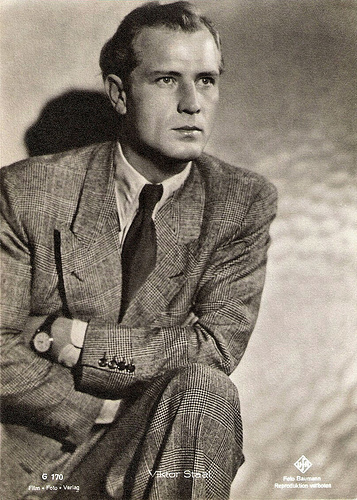
German postcard by Film-Foto-Verlag, no. G 170. Photo: Baumann / Ufa.
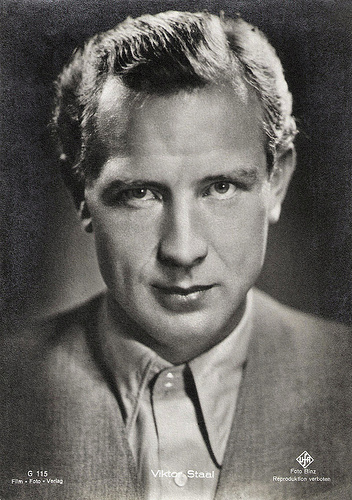
German postcard by Film-Foto-Verlag, no. G 115. Photo: Binz / Ufa.
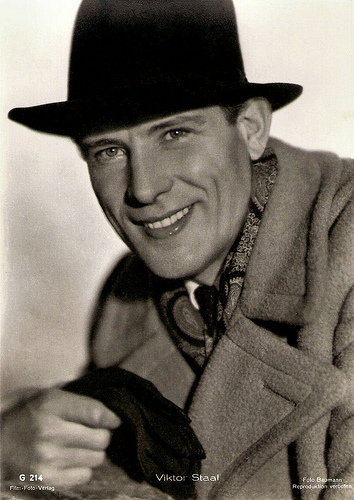
German postcard by Film-Foto-Verlag, no. G 214, 1941-1944. Photo: Baumann / Ufa.
Big, Blond and Blue-eyed
Viktor Staal was born Rudolf Viktor Stiaßny in Frankstadt, Austria-Hungary (now Franstat pod Radhostem, Czech Republic) in 1909. He attended acting classes in Vienna and got his first engagements at small theatres. Later he acted at the Volkstheater Wien where he had his breakthrough as an actor.
He made his film debut in 1935 in a bit part in the operetta Eva/Eva, the Factory Girl (Johannes Riemann, 1935) starring Magda Schneider . He also played small roles in such films as Alles für die Firma/Everything For the Firm (Rudolf Meinert, 1935) with Felix Bressart , and Das Einmaleins der Liebe/Love's Arithmetic (Carl Hoffmann, 1935) with Luise Ullrich .
In 1936 he played his first leading role opposite Anny Ondra in the adventure Donogoo Tonka (Reinhold Schünzel, 1936). This Austrian-German coproduction brought him to the Ufa studio in Berlin. Ufa offered the big, blond and blue-eyed Austrian a contract, and during the next years Staal became a popular Ufa star with successful films like Waldwinter/Winter in the Woods (Fritz Peter Buch, 1936), Ein Mädel vom Ballett/A Girl from the Chorus (Carl Lamac, 1937) with Anny Ondra , and Brillanten/Rhinestones (Eduard von Borsody, 1937).
In seven films, he appeared opposite Hansi Knoteck , including Waldwinter (1936), Brillanten (1937), Ritt in die Freiheit/Ride to Freedom (Karl Hartl, 1937), the comedy Eine Nacht im Mai/A Night in May (Georg Jacoby, 1938) with Marika Rökk, and Gewitter im Mai/Storms in May (Hans Deppe, 1938). Knoteck would become his wife in 1940.
A huge hit was the romantic drama Zu neuen Ufern/To New Shores (Detlef Sierck/Douglas Sirk, 1937), in which he starred opposite Zarah Leander . Other popular films were the musical comedy Capriccio (Karl Ritter, 1938) starring Lilian Harvey , and the romantic drama Umwege zum Glück/Detours To Happiness (Fritz Peter Buch, 1939) with Lil Dagover .
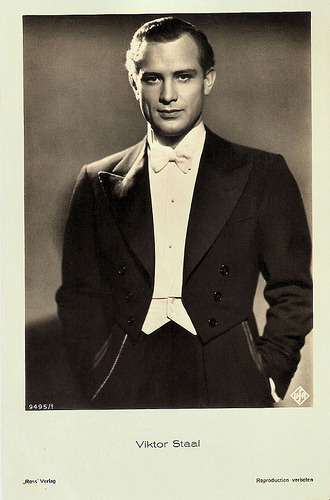
German postcard by Ross Verlag, no. 9495/1, 1935-1936. Photo: Ufa.
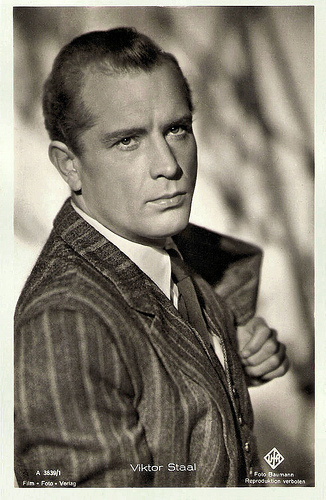
German postcard by Film-Foto-Verlag, no. A 3839/1, 1941-1944. Photo: Baumann / Ufa.
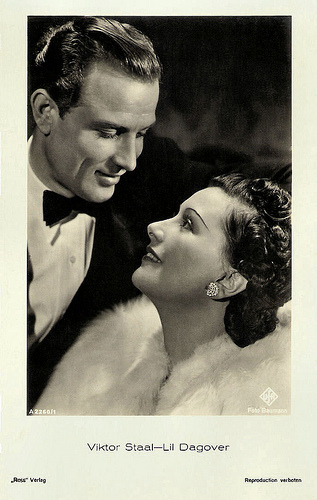
German postcard by Ross Verlag, no. A 2260/1, 1939-1940. Photo: Baumann / Ufa. Publicity still for Umwege zum Glück/Detours to happiness (Fritz Peter Buch, 1939) with Lil Dagover .
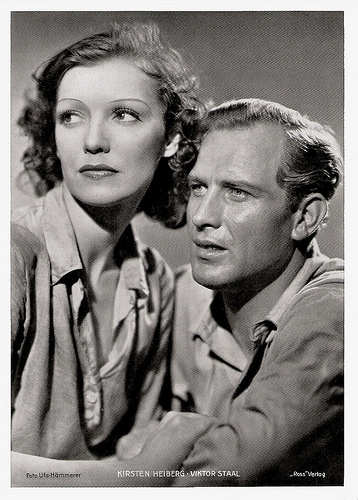
Big card by Ross Verlag. Photo: Hämmerer / Ufa. Publicity still for Frauen für Golden Hill/Women for Golden Hill (Erich Waschneck, 1938) with Kirsten Heiberg .
Great Box-Office Success
During World War II, Viktor Staal starred again with Zarah Leander in the slick romance Die grosse Liebe/The Great Love (Rolf Hansen, 1942) which became one of the greatest box office successes of the cinema of the Third Reich. He also played in productions like Zwielicht/Twilight (Rudolf van der Noss, 1940), the very funny musical comedy Hab' mich Lieb/Make Love To Me (Harald Braun, 1942) with Marika Rökk , the Henrik Ibsen adaptation Nora (Harald Braun, 1944), and the crime drama Via Mala (Josef von Báky, 1944-1948).
The original version of Via Mala was finished in March, 1944, but the propaganda ministry required director Von Baky to redo the ending. The censor accepted the film in March 1945, but changed his mind ten days later. Its official premiere was delayed until 16 January 1948.
After the war, Staal first worked on stage again at the Theater am Schiffbauerdamm in Berlin. During the war he had not appeared in notorious Nazi propaganda films so he was allowed to go on from his earlier successes in the film business, and would appear in 39 more films till 1977. He was still much in demand as the good-looking lover or husband in such films as Zwischen gestern und morgen/Between Yesterday and Tomorrow (Harald Braun, 1947) starring Hildegard Knef , Mathilde Möhring (Rolf Hansen, 1950) featuring Heidemarie Hatheyer , and Haus des Lebens/House of Life (Karl Hartl, 1952) with Cornell Borchers .
He grew out of the part though and played different roles in the thriller Spion für Deutschland/Spy for Germany (Werner Klingler, 1956) with Martin Held , the WW II drama Der Fuchs von Paris/The Fox of Paris (Paul May, 1957), and as Kara Ben Nemsi in the Karl May adaptation Die Sklavenkarawane/The Caravan of Slaves (Georg Marischka, Ramon Torrado, 1958).
When his film career dropped off he worked mainly for TV, such as in the well known series Landarzt Dr. Brock/Country Doctor Dr. Brock (1967-1969) with Rudolph Prack . To his last films belong Wilde Wasser/Wild Waters (Rudolf Schündler, 1962) with Marianne Hold , Der Jäger von Fall/The Hunter of Fall (Harald Reinl, 1974), and Die Standarte/The Standard (Ottokar Runze, 1977) with Jon Finch and Peter Cushing.
Viktor Staal passed away in 1982 in München (Munich), Germany. He and Hansi Knoteck had a son, Hannes (1942), who became an architect.
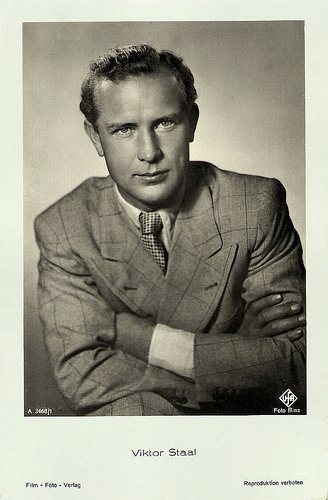
German postcard by Film-Foto-Verlag, no. A 3468/1, 1941-1944. Photo: Binz / Ufa.
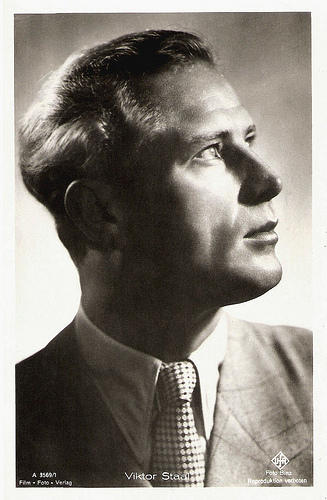
German postcard by Film-Foto-Verlag, no. A 3569/1, 1941-1944. Photo: Binz / Ufa.
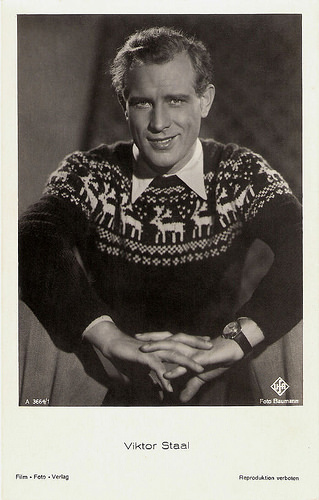
German postcard by Film-Foto-Verlag, no. A 3664/1, 1941-1944. Photo: Baumann / Ufa.
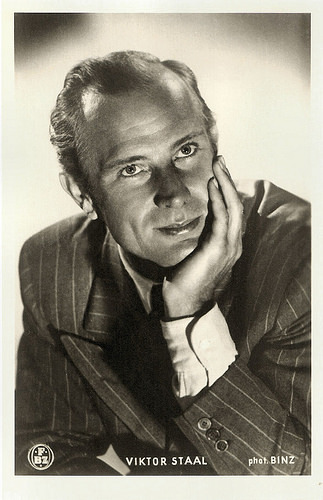
German postcard by F.B.Z. Photo: Binz.
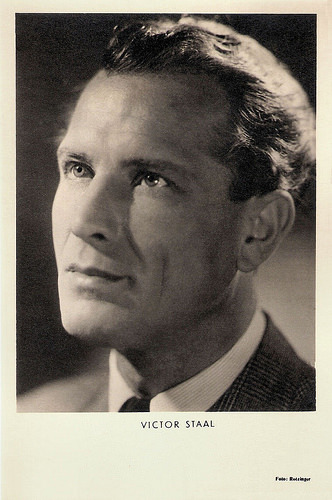
German postcard by Druck und Verlag Photo Kitt, München, no. 517. Photo: Rotzinger.
Sources: Stephanie D'heil (Steffi-Line) (German), Thomas Staedeli (Cyranos), Filmportal.de (German), Wikipedia and .

German postcard by Film-Foto-Verlag, no. G 170. Photo: Baumann / Ufa.

German postcard by Film-Foto-Verlag, no. G 115. Photo: Binz / Ufa.

German postcard by Film-Foto-Verlag, no. G 214, 1941-1944. Photo: Baumann / Ufa.
Big, Blond and Blue-eyed
Viktor Staal was born Rudolf Viktor Stiaßny in Frankstadt, Austria-Hungary (now Franstat pod Radhostem, Czech Republic) in 1909. He attended acting classes in Vienna and got his first engagements at small theatres. Later he acted at the Volkstheater Wien where he had his breakthrough as an actor.
He made his film debut in 1935 in a bit part in the operetta Eva/Eva, the Factory Girl (Johannes Riemann, 1935) starring Magda Schneider . He also played small roles in such films as Alles für die Firma/Everything For the Firm (Rudolf Meinert, 1935) with Felix Bressart , and Das Einmaleins der Liebe/Love's Arithmetic (Carl Hoffmann, 1935) with Luise Ullrich .
In 1936 he played his first leading role opposite Anny Ondra in the adventure Donogoo Tonka (Reinhold Schünzel, 1936). This Austrian-German coproduction brought him to the Ufa studio in Berlin. Ufa offered the big, blond and blue-eyed Austrian a contract, and during the next years Staal became a popular Ufa star with successful films like Waldwinter/Winter in the Woods (Fritz Peter Buch, 1936), Ein Mädel vom Ballett/A Girl from the Chorus (Carl Lamac, 1937) with Anny Ondra , and Brillanten/Rhinestones (Eduard von Borsody, 1937).
In seven films, he appeared opposite Hansi Knoteck , including Waldwinter (1936), Brillanten (1937), Ritt in die Freiheit/Ride to Freedom (Karl Hartl, 1937), the comedy Eine Nacht im Mai/A Night in May (Georg Jacoby, 1938) with Marika Rökk, and Gewitter im Mai/Storms in May (Hans Deppe, 1938). Knoteck would become his wife in 1940.
A huge hit was the romantic drama Zu neuen Ufern/To New Shores (Detlef Sierck/Douglas Sirk, 1937), in which he starred opposite Zarah Leander . Other popular films were the musical comedy Capriccio (Karl Ritter, 1938) starring Lilian Harvey , and the romantic drama Umwege zum Glück/Detours To Happiness (Fritz Peter Buch, 1939) with Lil Dagover .

German postcard by Ross Verlag, no. 9495/1, 1935-1936. Photo: Ufa.

German postcard by Film-Foto-Verlag, no. A 3839/1, 1941-1944. Photo: Baumann / Ufa.

German postcard by Ross Verlag, no. A 2260/1, 1939-1940. Photo: Baumann / Ufa. Publicity still for Umwege zum Glück/Detours to happiness (Fritz Peter Buch, 1939) with Lil Dagover .

Big card by Ross Verlag. Photo: Hämmerer / Ufa. Publicity still for Frauen für Golden Hill/Women for Golden Hill (Erich Waschneck, 1938) with Kirsten Heiberg .
Great Box-Office Success
During World War II, Viktor Staal starred again with Zarah Leander in the slick romance Die grosse Liebe/The Great Love (Rolf Hansen, 1942) which became one of the greatest box office successes of the cinema of the Third Reich. He also played in productions like Zwielicht/Twilight (Rudolf van der Noss, 1940), the very funny musical comedy Hab' mich Lieb/Make Love To Me (Harald Braun, 1942) with Marika Rökk , the Henrik Ibsen adaptation Nora (Harald Braun, 1944), and the crime drama Via Mala (Josef von Báky, 1944-1948).
The original version of Via Mala was finished in March, 1944, but the propaganda ministry required director Von Baky to redo the ending. The censor accepted the film in March 1945, but changed his mind ten days later. Its official premiere was delayed until 16 January 1948.
After the war, Staal first worked on stage again at the Theater am Schiffbauerdamm in Berlin. During the war he had not appeared in notorious Nazi propaganda films so he was allowed to go on from his earlier successes in the film business, and would appear in 39 more films till 1977. He was still much in demand as the good-looking lover or husband in such films as Zwischen gestern und morgen/Between Yesterday and Tomorrow (Harald Braun, 1947) starring Hildegard Knef , Mathilde Möhring (Rolf Hansen, 1950) featuring Heidemarie Hatheyer , and Haus des Lebens/House of Life (Karl Hartl, 1952) with Cornell Borchers .
He grew out of the part though and played different roles in the thriller Spion für Deutschland/Spy for Germany (Werner Klingler, 1956) with Martin Held , the WW II drama Der Fuchs von Paris/The Fox of Paris (Paul May, 1957), and as Kara Ben Nemsi in the Karl May adaptation Die Sklavenkarawane/The Caravan of Slaves (Georg Marischka, Ramon Torrado, 1958).
When his film career dropped off he worked mainly for TV, such as in the well known series Landarzt Dr. Brock/Country Doctor Dr. Brock (1967-1969) with Rudolph Prack . To his last films belong Wilde Wasser/Wild Waters (Rudolf Schündler, 1962) with Marianne Hold , Der Jäger von Fall/The Hunter of Fall (Harald Reinl, 1974), and Die Standarte/The Standard (Ottokar Runze, 1977) with Jon Finch and Peter Cushing.
Viktor Staal passed away in 1982 in München (Munich), Germany. He and Hansi Knoteck had a son, Hannes (1942), who became an architect.

German postcard by Film-Foto-Verlag, no. A 3468/1, 1941-1944. Photo: Binz / Ufa.

German postcard by Film-Foto-Verlag, no. A 3569/1, 1941-1944. Photo: Binz / Ufa.

German postcard by Film-Foto-Verlag, no. A 3664/1, 1941-1944. Photo: Baumann / Ufa.

German postcard by F.B.Z. Photo: Binz.

German postcard by Druck und Verlag Photo Kitt, München, no. 517. Photo: Rotzinger.
Sources: Stephanie D'heil (Steffi-Line) (German), Thomas Staedeli (Cyranos), Filmportal.de (German), Wikipedia and .
Published on October 14, 2015 22:00
October 13, 2015
Bufera (1926)
In the silent Italian mountain drama Bufera/The Storm (Wladimiro De Liguoro, 1926), Rina De Liguoro plays a woman seduced and abandoned by a rude mountain man. He leaves her with a child. When finally her life seems to retake thanks to another, kinder man, the first one reappears. Luckily a mountain storm swallows the inconvenient intruder.
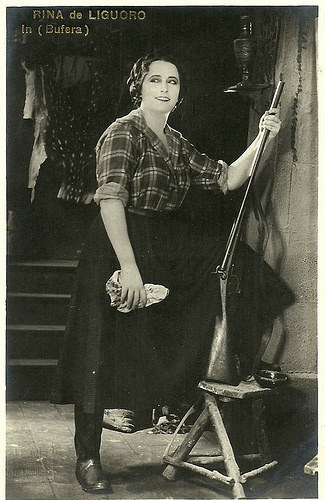
Italian postcard by Ed. G.B. Falci, Milano, no. 373. Photo: Rina De Liguoro in Bufera/The Storm (Wladimiro De Liguoro, 1926).
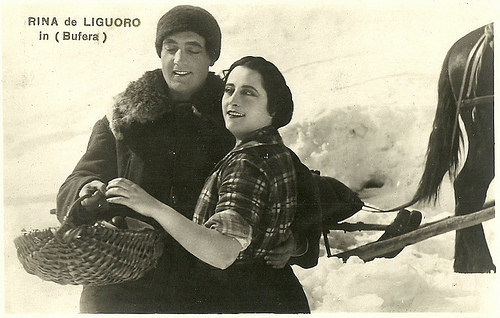
Italian postcard by Ed. G.B. Falci, Milano, no. 377. Photo: Rina De Liguoro and Celio Bucchi in Bufera/The Storm (Wladimiro De Liguoro, 1926).
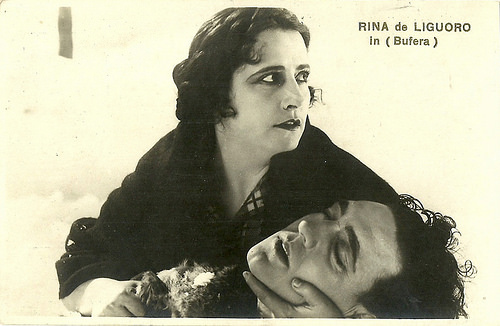
Italian postcard by Ed. G.B. Falci, Milano, no. 378. Photo: Rina De Liguoro and Celio Bucchi in Bufera/The Storm (Wladimiro De Liguoro, 1926).
Glittering Career
The star of Bufera was Rina De Liguoro (1892-1966), the last diva of the Italian silent cinema. She had her breakthrough in 1924 as the sensual, untamed Roman empress Messalina, and the beautiful countess continued her glittering career in such epics as Quo Vadis (1924), Casanova (1927) and Cecil B. De Mille's notorious Madam Satan (1930).
Her co-star was the athletic Celio Bucchi (1886-1964), an Italian actor who starred during the 1920s in adventure films like La congiura di San Marco/The conspiracy of San Marco (1924). Later he became a nameless extra and warehouse manager of a studio in Turin.
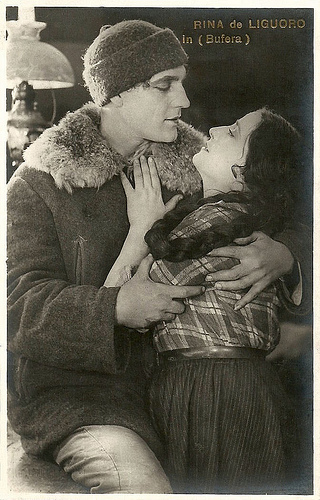
Italian postcard by Ed. G.B. Falci, Milano, no. 388. Photo: Rina De Liguoro and Celio Bucchi in Bufera (Wladimiro De Liguoro, 1926).
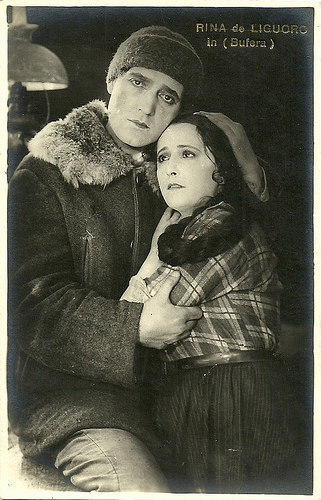
Italian postcard by Ed. G.B. Falci, Milano, no. 389. Photo: Rina De Liguoro and Celio Bucchi in Bufera/The Storm (Wladimiro De Liguoro, 1926).
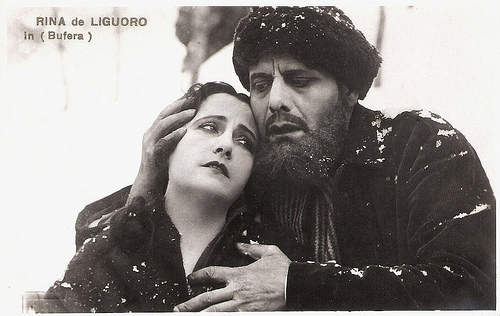
Italian postcard by G.B. Falci Editore, Milano, no. 393. Photo: publicity still for Bufera/Storm (Wladimiro De Liguoro, 1926).
Source: IMDb.

Italian postcard by Ed. G.B. Falci, Milano, no. 373. Photo: Rina De Liguoro in Bufera/The Storm (Wladimiro De Liguoro, 1926).

Italian postcard by Ed. G.B. Falci, Milano, no. 377. Photo: Rina De Liguoro and Celio Bucchi in Bufera/The Storm (Wladimiro De Liguoro, 1926).

Italian postcard by Ed. G.B. Falci, Milano, no. 378. Photo: Rina De Liguoro and Celio Bucchi in Bufera/The Storm (Wladimiro De Liguoro, 1926).
Glittering Career
The star of Bufera was Rina De Liguoro (1892-1966), the last diva of the Italian silent cinema. She had her breakthrough in 1924 as the sensual, untamed Roman empress Messalina, and the beautiful countess continued her glittering career in such epics as Quo Vadis (1924), Casanova (1927) and Cecil B. De Mille's notorious Madam Satan (1930).
Her co-star was the athletic Celio Bucchi (1886-1964), an Italian actor who starred during the 1920s in adventure films like La congiura di San Marco/The conspiracy of San Marco (1924). Later he became a nameless extra and warehouse manager of a studio in Turin.

Italian postcard by Ed. G.B. Falci, Milano, no. 388. Photo: Rina De Liguoro and Celio Bucchi in Bufera (Wladimiro De Liguoro, 1926).

Italian postcard by Ed. G.B. Falci, Milano, no. 389. Photo: Rina De Liguoro and Celio Bucchi in Bufera/The Storm (Wladimiro De Liguoro, 1926).

Italian postcard by G.B. Falci Editore, Milano, no. 393. Photo: publicity still for Bufera/Storm (Wladimiro De Liguoro, 1926).
Source: IMDb.
Published on October 13, 2015 22:00
October 12, 2015
Dolly Bouwmeester
Sweet Dutch stage actress Dolly Bouwmeester (1913-1986) was born in a famous theatre dynasty and she was the younger sister of Dutch film diva Lily Bouwmeester. Although Dolly made films in the Netherlands, France, Germany and Great-Britain, her film career would never take off.
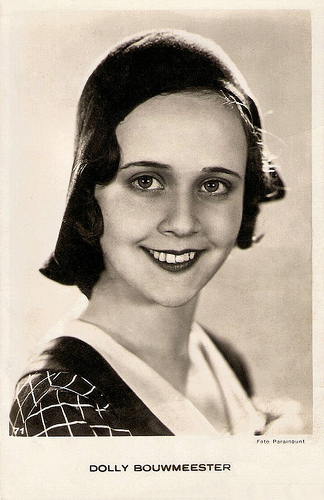
Dutch Postcard, no. 71, 1931. Photo: Paramount.
Early Dutch Sound Films
Dolly Bouwmeester was born in 1913 in The Hague, Netherlands. She was the daughter of violinist Louis Adolf Bouwmeester and the Belgian pianist Julie Arpeau dit Du Rosay. She was the younger sister of Dutch film diva Lily Bouwmeester and twin sister of dancer and mime artist Louis 'Loutje' Bouwmeester.
As a young girl, she started her career as a stage actress in 1927. She debuted at the age of fourteen at the Hofstad Theatre in Rotterdam in the comedy Het premielot (The premium lottery ticket), in which she played a boy. In the following years she worked with Cor Ruys for the Dutch East Indies Theatre, where she mainly acted in comedies. Then she worked for the theatre company of Cor van der Lugt Melsert.
She starred in three early Dutch sound films. First, she was engaged for the Dutch experimental sound film Finale/Final (Gerard Rutten, 1931) in which Adolphe Engers starred as a demonic mortician. The film was never finished because of financial problems and now only some footage remains.
That same year, Dolly went to the Paramount studios in France for another experimental sound film, De sensatie der toekomst/The Sensation of the Future (Victor Buchowetzki, Jack Salvatori, 1931). She continued her stage career in September 1931 with the theatre company of Louis Davids and played with him and Corry Vonk in the play In 't witte paard (The White Horse Inn).
Four years later, Bouwmeester travelled to Berlin to play the title role in the film Fientje Peters - poste restante (Victor Janson, 1935) with Herman Tholen and Louis Borel . It was the alternate-language version of the German film Hilde Petersen postlagernd/Hilde Petersen: General Delivery (Victor Janson, 1936).
None of her films were successful. In 1935 she married with Brit John Jackson and emigrated to London. There she acted in one more film The Jack of Diamonds (Vernon Sewell, 1949) with Nigel Patrick, who also co-wrote the screenplay. The low-budget thriller was made by Vernon Sewell's own production company.
After the death of her husband Dolly Bouwmeester returned to the Netherlands. She died in 1986 in Leiden, The Netherlands, at the age of 73.
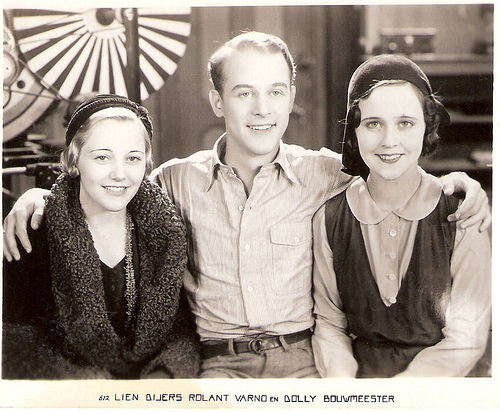
Lien Deyers, Roland Varno & Dolly Bouwmeester. Dutch Postcard, no. 512. Photo: Paramount. Publicity still for De sensatie der toekomst (1931).
The Sensation of the Future
The postcards above were both produced for the Science Fiction detective film De sensatie der toekomst/The Sensation of the Future (also known as Televisie/Television) about the new phenomenon television - the 'sensation of the future'.
At the time of her film debut, Dolly was only only 18 years old. Her co-stars were the young Dutch actors Lien Deyers and Roland Varno, who both already had acted in German films.
De sensatie der toekomst was a Dutch version of the American-French production Magie Moderne (Dimitri Buchowetzki, 1931), filmed in Les Studios Paramount in Joinville-le-pont, a commune in the southeastern suburbs of Paris, France. On the same set versions for Italy, Romania, Czechoslovakia and Sweden were made with different actors.
The television scenes, including fragments with Bedouins and Rif Kabyles in Morocco, and Clara Bow romping on a New York beach, were for all alternative language versions the same.
Although Paramount finished De sensatie der toekomst/The Sensation of the Future in February 1931, the studio did not release the film in the Dutch cinemas until Octobre. The reviews were lukewarm.
The first Dutch sound feature was soon forgotten and nowadays it is assumed to be lost.
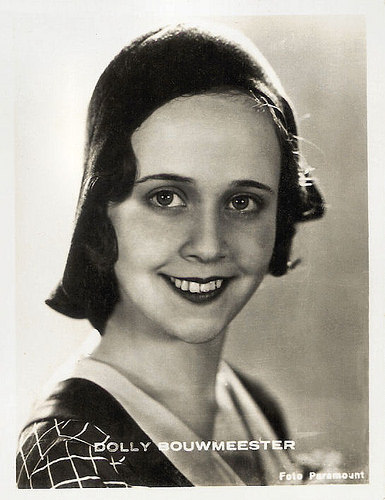
Small German collectors card. Photo: Paramount. Publicity still for De sensatie der toekomst/Television (1931).
Sources: Simon Koster (De Bouwmeesters - Dutch), Gerard Rutten (Mijn papieren camera - Dutch), Eric Winter (Weekblad Cinema en Theater @ Virtual History - Dutch), Filmtotaal. (Dutch), Wikipedia (Dutch) and .

Dutch Postcard, no. 71, 1931. Photo: Paramount.
Early Dutch Sound Films
Dolly Bouwmeester was born in 1913 in The Hague, Netherlands. She was the daughter of violinist Louis Adolf Bouwmeester and the Belgian pianist Julie Arpeau dit Du Rosay. She was the younger sister of Dutch film diva Lily Bouwmeester and twin sister of dancer and mime artist Louis 'Loutje' Bouwmeester.
As a young girl, she started her career as a stage actress in 1927. She debuted at the age of fourteen at the Hofstad Theatre in Rotterdam in the comedy Het premielot (The premium lottery ticket), in which she played a boy. In the following years she worked with Cor Ruys for the Dutch East Indies Theatre, where she mainly acted in comedies. Then she worked for the theatre company of Cor van der Lugt Melsert.
She starred in three early Dutch sound films. First, she was engaged for the Dutch experimental sound film Finale/Final (Gerard Rutten, 1931) in which Adolphe Engers starred as a demonic mortician. The film was never finished because of financial problems and now only some footage remains.
That same year, Dolly went to the Paramount studios in France for another experimental sound film, De sensatie der toekomst/The Sensation of the Future (Victor Buchowetzki, Jack Salvatori, 1931). She continued her stage career in September 1931 with the theatre company of Louis Davids and played with him and Corry Vonk in the play In 't witte paard (The White Horse Inn).
Four years later, Bouwmeester travelled to Berlin to play the title role in the film Fientje Peters - poste restante (Victor Janson, 1935) with Herman Tholen and Louis Borel . It was the alternate-language version of the German film Hilde Petersen postlagernd/Hilde Petersen: General Delivery (Victor Janson, 1936).
None of her films were successful. In 1935 she married with Brit John Jackson and emigrated to London. There she acted in one more film The Jack of Diamonds (Vernon Sewell, 1949) with Nigel Patrick, who also co-wrote the screenplay. The low-budget thriller was made by Vernon Sewell's own production company.
After the death of her husband Dolly Bouwmeester returned to the Netherlands. She died in 1986 in Leiden, The Netherlands, at the age of 73.

Lien Deyers, Roland Varno & Dolly Bouwmeester. Dutch Postcard, no. 512. Photo: Paramount. Publicity still for De sensatie der toekomst (1931).
The Sensation of the Future
The postcards above were both produced for the Science Fiction detective film De sensatie der toekomst/The Sensation of the Future (also known as Televisie/Television) about the new phenomenon television - the 'sensation of the future'.
At the time of her film debut, Dolly was only only 18 years old. Her co-stars were the young Dutch actors Lien Deyers and Roland Varno, who both already had acted in German films.
De sensatie der toekomst was a Dutch version of the American-French production Magie Moderne (Dimitri Buchowetzki, 1931), filmed in Les Studios Paramount in Joinville-le-pont, a commune in the southeastern suburbs of Paris, France. On the same set versions for Italy, Romania, Czechoslovakia and Sweden were made with different actors.
The television scenes, including fragments with Bedouins and Rif Kabyles in Morocco, and Clara Bow romping on a New York beach, were for all alternative language versions the same.
Although Paramount finished De sensatie der toekomst/The Sensation of the Future in February 1931, the studio did not release the film in the Dutch cinemas until Octobre. The reviews were lukewarm.
The first Dutch sound feature was soon forgotten and nowadays it is assumed to be lost.

Small German collectors card. Photo: Paramount. Publicity still for De sensatie der toekomst/Television (1931).
Sources: Simon Koster (De Bouwmeesters - Dutch), Gerard Rutten (Mijn papieren camera - Dutch), Eric Winter (Weekblad Cinema en Theater @ Virtual History - Dutch), Filmtotaal. (Dutch), Wikipedia (Dutch) and .
Published on October 12, 2015 22:00
October 11, 2015
Jacques Sernas
Lithuanian-born French actor Jacques (sometimes: Jack) Sernas (1925) had an international film career of more than sixty years. First the handsome blonde appeared as the hero of Peplum spectacles and adventure films and later he worked as a character actor. Sernas is perhaps best-known as Paris in the Hollywood epic Helen of Troy (1956).
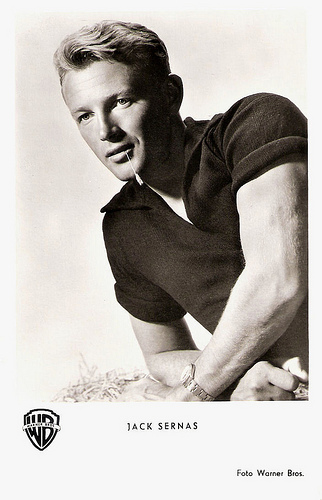
German postcard by Kunst und Bild, Berlin, no. T 650. Photo: Warner Bros. Publicity still for Helen of Troy (Robert Wise, 1956).
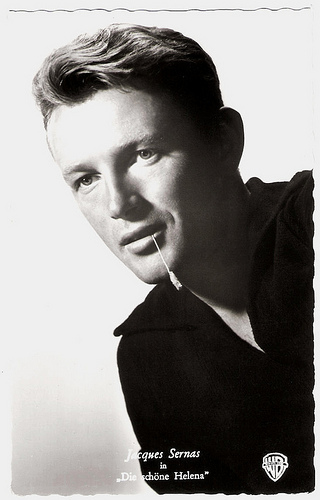
German postcard by Kolibi-Verlag, Minden/Westf., no. 1906. Photo: Warner Bros. Publicity still for Helen of Troy (Robert Wise, 1956).
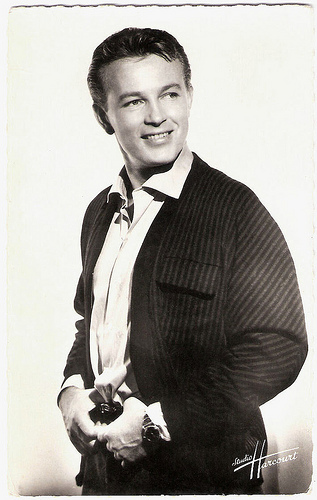
French postcard by Editions du Globe, Paris, no. 694. Photo: Studio Harcourt.
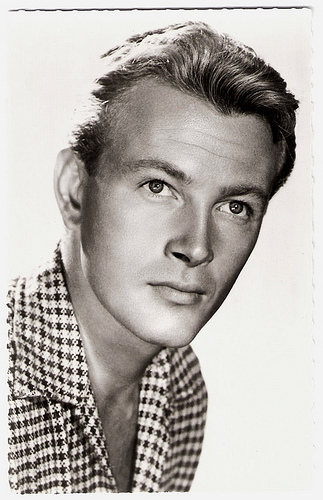
French postcard by Editions P.I., Paris, presented by Les Carbones Korès 'Carboplane', no. 804. Photo: Sam Lévin.
Buchenwald
Jacques Sernas was born as Jurgis Šernas in Kaunas, Lithuania in 1925. Sernas was the son of the Baltic minister of justice, Jokūbas Šernas, a signatory of the Act of Independence of Lithuania in 1918. He died six years later when Jacques was a year old. His Russian mother took him to Paris where he received his formal education.
Still at school, he joined the French Resistance and was captured. For more than a year he was interned at concentration camp Buchenwald, where he had to do hard labour. After the war Sernas started a medicine study, but broke this off rapidly. To be able to keep his mother and himself financially above the water, he did all kind of odd jobs such as night watchman, waiter in the Café de la Paix, and skiing instructor in Chamonix. He also tried briefly as a journalist - he was a correspondent for the journal Combat at the Nuremberg processes – but he also gave up this career.
In 1947 he appeared for the first times before the camera in the Italian film drama Gioventù perduta/Lost Youth (Pietro Germi, 1947) with Carla del Poggio and Massimo Girotti and in the French Film Noir Miroir/Mirror (Raymond Lavy, 1947) with Jean Gabin and Martine Carol . Thus started a career lasting more than 60 years.
Sernas was noted for 'his eye-catching good looks' (according to Gary Brumburgh at IMDb ), and soon appeared in many jeune premier roles. Sernas cut a fine figure in European spectacles as Il falco rosso/The Red Falcon (Carlo Ludovico Bragaglia, 1949), Il mulino del Po/The Mill on the Po (Alberto Lattuada, 1949) with Carla del Poggio , Il lupo della Sila/Lure of the Sila (Duilio Coletti, 1949) with Silvana Mangano , Barbe-Bleue/Bluebeard (Christian Jacque, 1951) with Cécile Aubry , and Camicie rosse/Anita Garibaldi (Goffredo Alessandrini, 1952) starring Anna Magnani .
He hit major international attention after being cast as Paris, opposite sex sirens Rosanna Podestà and Brigitte Bardot in the historical epic Helen of Troy (Robert Wise, 1956). Hollywood took brief notice but nothing much came of it. In his few American films and TV series he appeared under the name Jack Sernas.
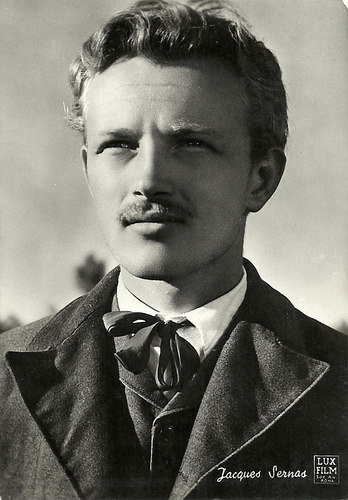
Italian postcard by Ed. Garami, no. 103. Photo: Italfoto / Lux Film. Publicity still for Il mulino del Po/The Mill on the Po (Alberto Lattuada, 1949).
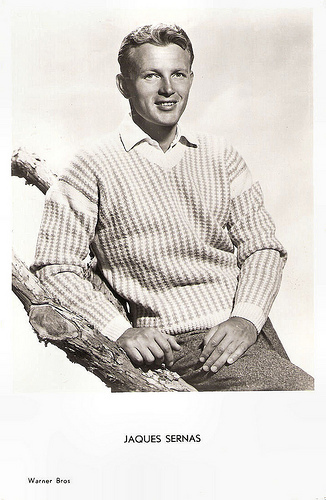
Dutch postcard, no. 109. Photo: Warner Bros.
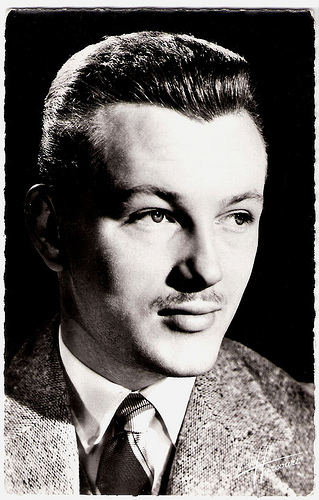
French postcard by Editions du Globe, Paris, no. 179. Photo: Studio Harcourt.
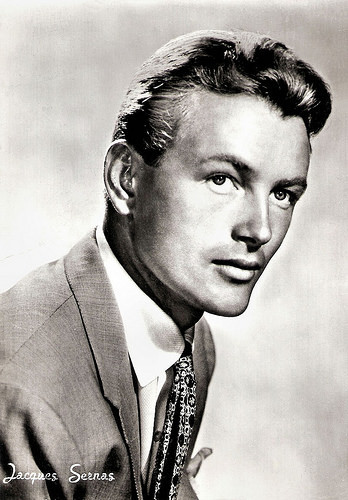
Italian postcard by S.A. Poligrafica Sammarinese, no. 004u.
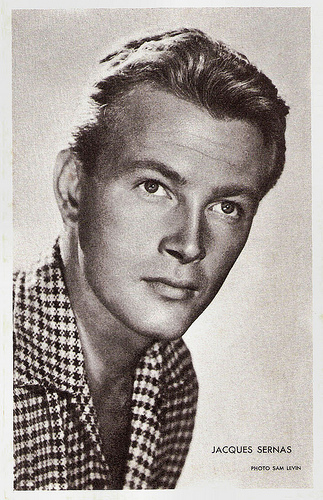
French collector's card, offered by Royal Chewing-Gum. Photo: Sam Lévin.
Fading Matinee Idol
After two years in Hollywood, Jacques Sernas returned to Europe and settled in Rome. Since then he was mainly seen in Italian productions. He was relegated for the most part to supporting characters, but he made one lasting impression as a fading matinee idol in Fellini's masterpiece La Dolce Vita (Federico Fellini, 1960).
Other interesting films were Un amore a Roma/Love in Rome (Dino Risi, 1960), and the war satire Il giorno più corto/The Shortest Day (Sergio Corbucci, 1963). Sernas appeared in international productions as 55 Days at Peking (Nicholas Ray, 1963) with Charlton Heston and Ava Gardner.
In 1966 he wrote his so far single screenplay, Zarabanda Bing Bing/Balearic Caper (José María Forqué, 1966) a satire on the James Bond films, in which Sernas also played the leading part. Later films included the shocking Curzio Malaparte adaptation La Pelle/The Skin (Liliana Cavani, 1981) starring Marcello Mastroianni , and L'africana/The African Woman (Margaretha von Trotta, 1990) with Stefania Sandrelli.
About the private life of Jacques Sernas is little known. In June, 1955 he married the Romanian journalist Maria Stella Signorini. The following year he became father of a daughter. Unknown is if he was married more times, or if he had more children.
His most recent appearances have been as a Cardinal in a TV film biopic Papa Giovanni - Ioannes XXIII/ Pope John XXIII (Giorgio Capitani, 2002) with Edward Asner, and in the TV mini-series Papa Luciani: Il sorriso di Dio/Pope Luciani: God's smile (Giorgio Capitani, 2006) with Franco Interlenghi .
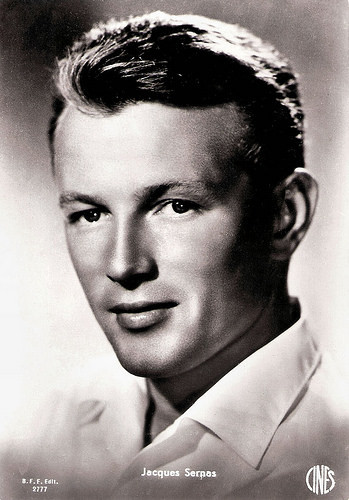
Italian postcard by B.F.F. Edit., no. 2777. Photo: Cines.
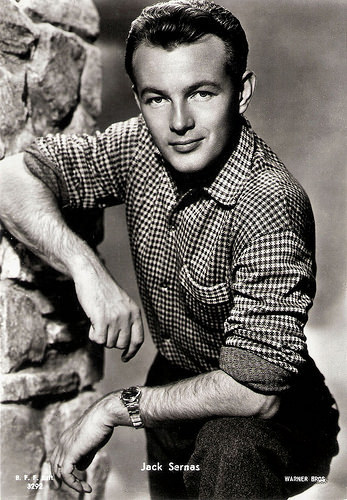
Italian postcard by B.F.F. Edit., no. 3292. Photo: Warner Bros.
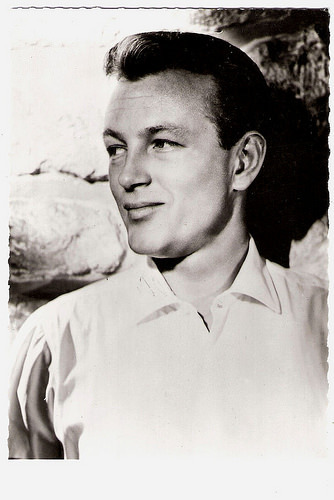
French postcard by Editions P.I., Paris, presented by Les Carbones Korès 'Carboplane', no. 914. Photo: Studio Bernard & Vauclair.
Trailer for Helen of Troy (1956). Source: 50sMovieBlitzz (YouTube).
Trailer for La Dolce Vita (1960). Source: Pulp59 (YouTube).
Sources: (IMDb), Wikipedia (French), and .

German postcard by Kunst und Bild, Berlin, no. T 650. Photo: Warner Bros. Publicity still for Helen of Troy (Robert Wise, 1956).

German postcard by Kolibi-Verlag, Minden/Westf., no. 1906. Photo: Warner Bros. Publicity still for Helen of Troy (Robert Wise, 1956).

French postcard by Editions du Globe, Paris, no. 694. Photo: Studio Harcourt.

French postcard by Editions P.I., Paris, presented by Les Carbones Korès 'Carboplane', no. 804. Photo: Sam Lévin.
Buchenwald
Jacques Sernas was born as Jurgis Šernas in Kaunas, Lithuania in 1925. Sernas was the son of the Baltic minister of justice, Jokūbas Šernas, a signatory of the Act of Independence of Lithuania in 1918. He died six years later when Jacques was a year old. His Russian mother took him to Paris where he received his formal education.
Still at school, he joined the French Resistance and was captured. For more than a year he was interned at concentration camp Buchenwald, where he had to do hard labour. After the war Sernas started a medicine study, but broke this off rapidly. To be able to keep his mother and himself financially above the water, he did all kind of odd jobs such as night watchman, waiter in the Café de la Paix, and skiing instructor in Chamonix. He also tried briefly as a journalist - he was a correspondent for the journal Combat at the Nuremberg processes – but he also gave up this career.
In 1947 he appeared for the first times before the camera in the Italian film drama Gioventù perduta/Lost Youth (Pietro Germi, 1947) with Carla del Poggio and Massimo Girotti and in the French Film Noir Miroir/Mirror (Raymond Lavy, 1947) with Jean Gabin and Martine Carol . Thus started a career lasting more than 60 years.
Sernas was noted for 'his eye-catching good looks' (according to Gary Brumburgh at IMDb ), and soon appeared in many jeune premier roles. Sernas cut a fine figure in European spectacles as Il falco rosso/The Red Falcon (Carlo Ludovico Bragaglia, 1949), Il mulino del Po/The Mill on the Po (Alberto Lattuada, 1949) with Carla del Poggio , Il lupo della Sila/Lure of the Sila (Duilio Coletti, 1949) with Silvana Mangano , Barbe-Bleue/Bluebeard (Christian Jacque, 1951) with Cécile Aubry , and Camicie rosse/Anita Garibaldi (Goffredo Alessandrini, 1952) starring Anna Magnani .
He hit major international attention after being cast as Paris, opposite sex sirens Rosanna Podestà and Brigitte Bardot in the historical epic Helen of Troy (Robert Wise, 1956). Hollywood took brief notice but nothing much came of it. In his few American films and TV series he appeared under the name Jack Sernas.

Italian postcard by Ed. Garami, no. 103. Photo: Italfoto / Lux Film. Publicity still for Il mulino del Po/The Mill on the Po (Alberto Lattuada, 1949).

Dutch postcard, no. 109. Photo: Warner Bros.

French postcard by Editions du Globe, Paris, no. 179. Photo: Studio Harcourt.

Italian postcard by S.A. Poligrafica Sammarinese, no. 004u.

French collector's card, offered by Royal Chewing-Gum. Photo: Sam Lévin.
Fading Matinee Idol
After two years in Hollywood, Jacques Sernas returned to Europe and settled in Rome. Since then he was mainly seen in Italian productions. He was relegated for the most part to supporting characters, but he made one lasting impression as a fading matinee idol in Fellini's masterpiece La Dolce Vita (Federico Fellini, 1960).
Other interesting films were Un amore a Roma/Love in Rome (Dino Risi, 1960), and the war satire Il giorno più corto/The Shortest Day (Sergio Corbucci, 1963). Sernas appeared in international productions as 55 Days at Peking (Nicholas Ray, 1963) with Charlton Heston and Ava Gardner.
In 1966 he wrote his so far single screenplay, Zarabanda Bing Bing/Balearic Caper (José María Forqué, 1966) a satire on the James Bond films, in which Sernas also played the leading part. Later films included the shocking Curzio Malaparte adaptation La Pelle/The Skin (Liliana Cavani, 1981) starring Marcello Mastroianni , and L'africana/The African Woman (Margaretha von Trotta, 1990) with Stefania Sandrelli.
About the private life of Jacques Sernas is little known. In June, 1955 he married the Romanian journalist Maria Stella Signorini. The following year he became father of a daughter. Unknown is if he was married more times, or if he had more children.
His most recent appearances have been as a Cardinal in a TV film biopic Papa Giovanni - Ioannes XXIII/ Pope John XXIII (Giorgio Capitani, 2002) with Edward Asner, and in the TV mini-series Papa Luciani: Il sorriso di Dio/Pope Luciani: God's smile (Giorgio Capitani, 2006) with Franco Interlenghi .

Italian postcard by B.F.F. Edit., no. 2777. Photo: Cines.

Italian postcard by B.F.F. Edit., no. 3292. Photo: Warner Bros.

French postcard by Editions P.I., Paris, presented by Les Carbones Korès 'Carboplane', no. 914. Photo: Studio Bernard & Vauclair.
Trailer for Helen of Troy (1956). Source: 50sMovieBlitzz (YouTube).
Trailer for La Dolce Vita (1960). Source: Pulp59 (YouTube).
Sources: (IMDb), Wikipedia (French), and .
Published on October 11, 2015 22:00
October 10, 2015
Lotte Neumann
Yesterday, it was the final day of Le Giornate del Cinema Muto in Pordenone. Today, we're back home in Amsterdam, but EFSP has still one more silent star for you, Lotte Neumann (1896-1977). In Pordenone we saw her in the Ernst Lubitsch comedy Romeo und Julia im Schnee/Romeo and Juliet in the Snow (1920). Neumann was one of the most successful actresses in the early days of the German silent cinema, and she also worked as a screenwriter and a producer.
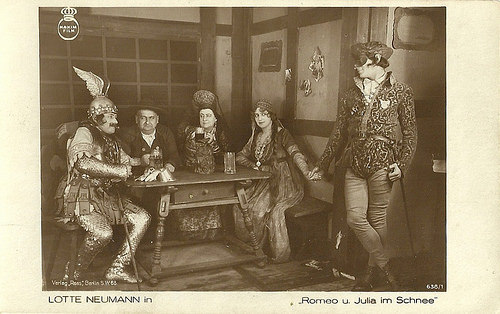
German postcard by Ross Verlag, no. 636/1. Photo: Maxim Film. Publicity still for the Ernst Lubitsch comedy Romeo und Julia im Schnee/Romeo and Juliet in the Snow (1920). The man on the left dressed as an antique hero could be Julius Falkenstein as Paris. The others are from left to right Jakob Tiedtke (Herr Capulethofer), Marga Köhler (his wife), Lotte Neumann (Julia) and Gustav von Wangenheim (Romeo Montekugerl).
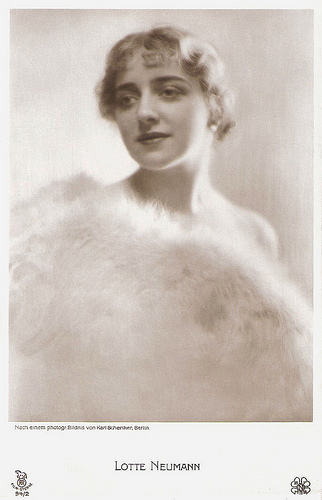
German postcard by Rotophot in the Film-sterne series, no. 94/2. Photo: NBFMB / Karl Schenker.
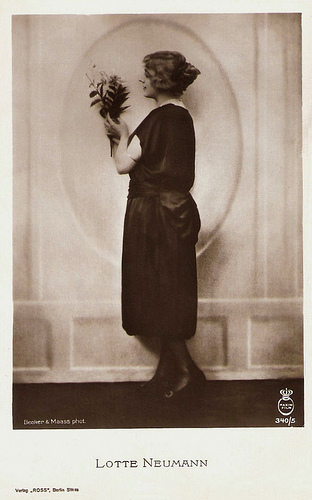
German postcard by Ross Verlag, Berlin, no. 340/5, 1919-1924. Photo: Becker & Maass / Maxim Film.
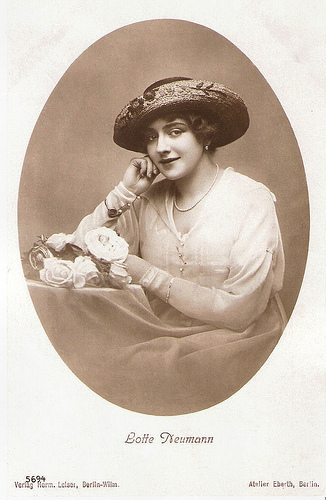
German postcard by Verlag Hermann Leiser, Berlin-Wilm., no. 5694. Photo: Atelier Eberth, Berlin.
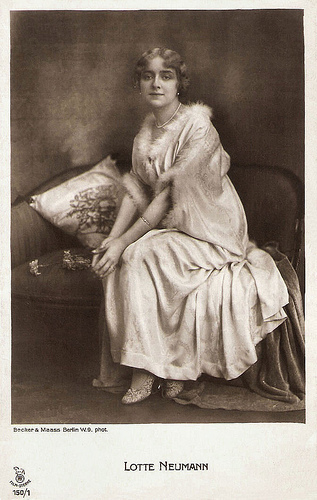
German postcard by Rotophot, Berlin, in the Film-sterne Series, no. 150/1, 1925-1935. Photo: Becker & Maass.
Sherlock Holmes
Lotte Neumann was born as Charlotte Pötler in Berlin, Germany, in 1896.
She attended the Königliche Luisenschule (Royal Louise School) in Berlin, after which the Wagnersche-Klinkhardsche Höhere Mädchenschule (Wagnerian-Klinkhardsche Higher School for Girls).
She began her theatrical career as a 13-year-old choir singer at the Komische Oper (Comic Opera) and at the Komödienhaus (Comedy House) in Berlin.
In 1912, director Max Mack gave her her first film role in Die Launen des Schicksals/Whims of Fate (Max Mack, 1912) with Hanni Weisse .
In the following years she acted in productions of the German Mutoscope and Biograph GmbH like Ketten der Vergangenheit/Chains of the Past (1914), the Sherlock Holmes-film Ein seltsamer Fall/An Unusual Case (Max Mack, 1914), Der eiserne Ring/The Iron Ring (Paul von Woringen, 1915) and In letzter Sekunde/In the Last Second (Walter Schmidthässler, 1916).
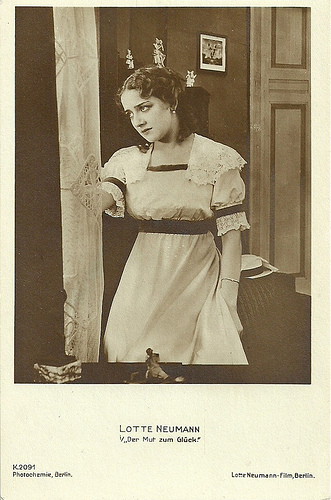
German postcard by Photochemie, Berlin, no. K. 2091. Photo: Lotte Neumann-Film, Berlin. Still of Lotte Neumann in Der Mut zum Glück/The Courage to Happiness (Paul von Woringen, 1917). This was the first film Neumann produced herself with her company Lotte Neumann-Film.
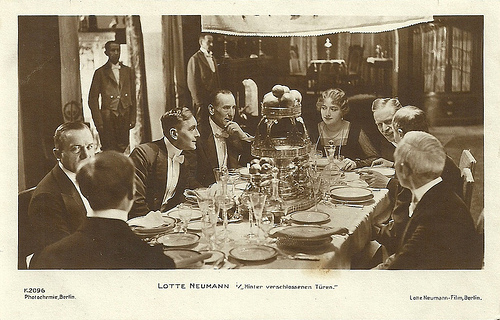
German postcard by Photochemie, Berlin, K. 2096. Photo: Lotte Neumann-Film, Berlin. Still of Lotte Neumann and Ernst Rückert in Hinter verschlossenen Türen/Behind Closed Doors (Paul von Woringen, 1917).

German postcard by Photochemie, no. K. 2168. Photo: Lotte Neumann-Film, Berlin. Publicity still for Die Ehe der Charlotte von Brakel/The Marriage of Charlotte von Brakel (Paul von Woringen, 1918).
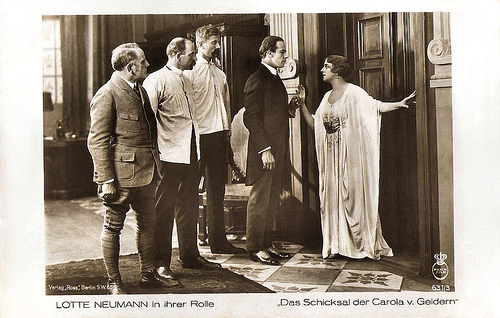
German postcard by Ross Verlag, Berlin, no. 631/3, 1919-1924. Photo: Maxim Film. Publicity still for Das Schicksal der Carola von Geldern/The fate of Carola von Geldern (Carl Froelich, 1919).
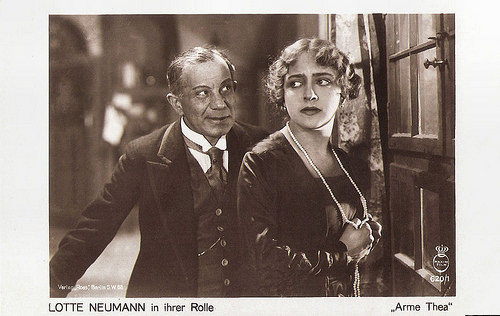
German postcard by Ross Verlag, Berlin, no. 620/1, 1919-1924. Photo: Maxim Film. Publicity still for Arme Thea/Poor Thea (Carl Froelich, 1919).
Shadows of the Past
Lotte Neumann also appeared as a singer and actress on Berlin stages. Soon she was so well-known that the studio shot a whole series of Lotte Neumann-films.
In 1916 she founded the Lotte Neumann Film GmbH, which existed until 1919.
To these productions belong Hinter verschlossenen Türen/Behind Closed Doors (Paul von Woringen, 1917), Die Richterin/The Judge (Paul von Woringen, 1917), Das Schweigen im Walde/The Silence in the Forest (Paul von Woringen, 1918), Das Spiel mit dem Feuer/The Play With Fire (Paul von Woringen, 1918) and Schatten der Vergangenheit/Shadows of the Past (Paul von Woringen, 1919) - for which she was also the producer.
In 1918 she wrote her first screenplay, for Die Töchter des Herrn Dornberg/The daughters of Mr. Dornberg (Paul of Woringen, 1918).
From 1919 on she was committed to the Ufa.
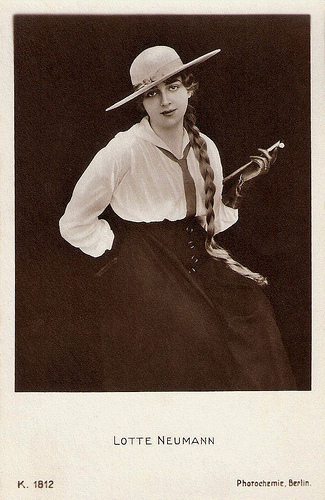
German postcard by Photochemie, Berlin, no. K. 1812.
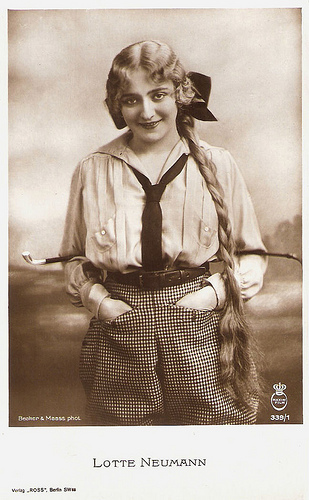
German postcard by Ross Verlag, Berlin, no. 339/1, 1919-1924. Photo: Becker & Maass / Maxim Film.
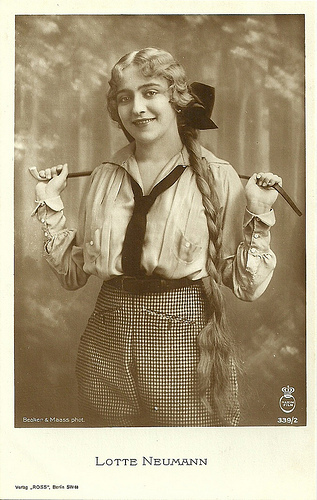
German postcard by Ross Verlag, Berlin, no. 339/2, 1919-1924. Photo: Becker & Maass / Maxim Film.
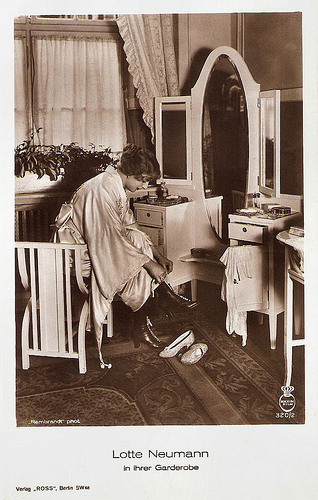
German postcard by Ross Verlag, no. 320/2, 1919-1924. Photo: Rembrandt / Maxim Film. Caption: Lotte Neumann in ihrer garderobe (Lotte Neumann in her wardrobe).
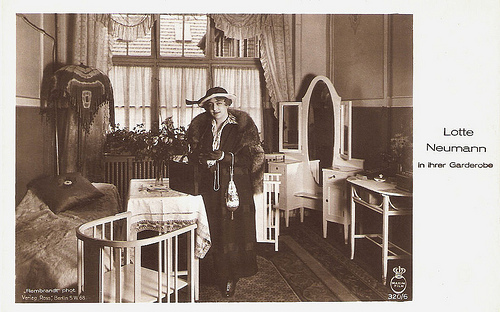
German postcard by Ross Verlag, Berlin, no. 320/6, 1919-1924. Photo: Rembrandt / Maxim Film. Caption: Lotte Neumann in ihrer garderobe (Lotte Neumann in her wardrobe).
Protracted Divorce Case
During the 1920s, Lotte Neumann remained a popular film actress who embodied aristocratic young women.
In 1920 she acted under the direction of Ernst Lubitsch in the comedy Romeo und Julia im Schnee/Romeo and Juliet in the Snow (1920), set in a 19th century Alpine village.
Her biggest successes include the film operetta Die brigantin von New York/The Brigantine, New York (Hans Werckmeister, 1924), Die frau für 24 stunden/The Woman for 24 hours (Reinhold Schünzel, 1925) with Harry Liedtke , and Der gute Ruf/The Good Reputation (Pierre Marodon, 1926).
She had film contracts in Austria, Italy and the Balkan States, for example, with Gaumont-Aubert in Paris and with Maldaria in Prague.
Because of her protracted divorce case, which ran from 1929 to 1932, she had to end her career as an actress. Her last film was Die Liebesfiliale (Carl Heinz Wolff, 1931) before she retired from the screen.
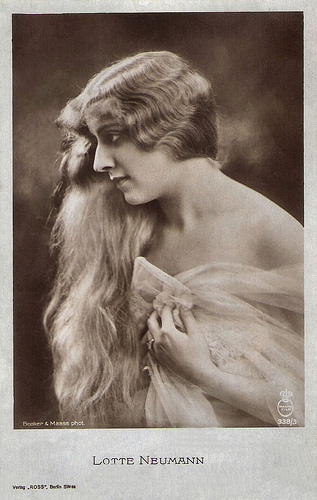
German postcard by Ross Verlag, Berlin, no. 338/3, 1919-1924. Photo: Maxim Film / Becker & Maass.
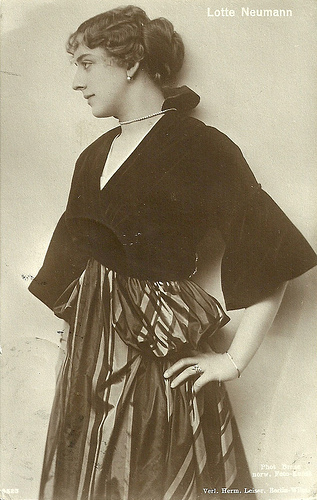
German postcard by Verlag Hermann Leiser, Berlin.
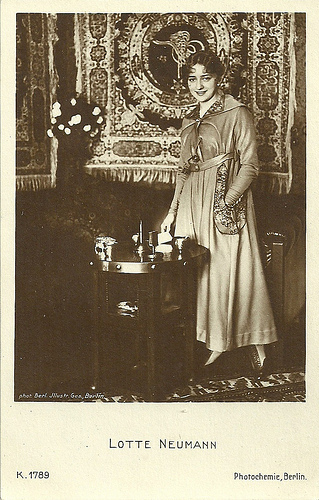
German postcard by Photochemie, Berlin, no. K. 1789. Photo: Berliner Illustrierte Ges. [Gesellschaft], Berlin.
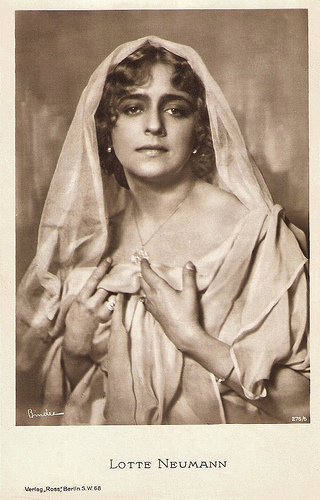
German postcard by Ross Verlag, no. 276/6, 1919-1924. Photo: Alex Binder.
Screenplays
From 1933, Lotte Neumann worked as a film writer under the pseudonym C.H. Diller. Diller was the maiden name of her mother.
In 1935, she married screenwriter Walter Wassermann and also started a professional partnership with him, which lasted until 1944.
She wrote a total of 25 screenplays including Kora Terry (Georg Jacobi, 1940) for Ufa; Friedrich Schiller (Herbert Maisch, 1939) for Tobis; together with Walter Wassermann Die nacht in Venedig/The Night in Venice (Paul Verhoeven, 1941), and Altes herz wird wieder jung/Old Heart Young Again (Erich Engel, 1942), both for Tobis.
After the war, she continued her work with two more screenplays for small productions until 1958.
She went to live at the residence of her mother in Gmund am Tegernsee, and later lived in Gaißach.
Lotte Neumann died in 1977 in Gaißach, Germany.
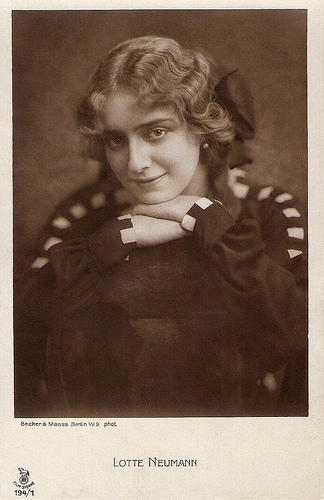
German postcard by Rotophot in the Film-sterne series, no. 194/1. Photo: Becker & Maass, Berlin.
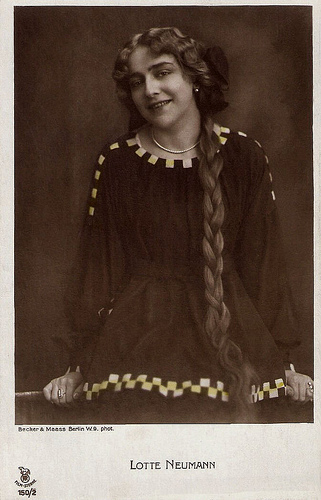
German postcard by Rotophot in the Film-sterne series, no. 150/2. Photo: Becker & Maass, Berlin.
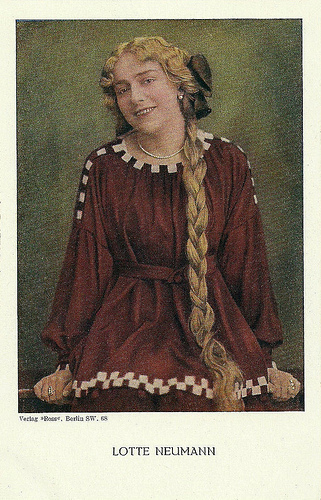
German postcard by Ross Verlag, Berlin.
Sources: Gabriele Hansch/Gerlinde Waz (Filmpionierinnen in Deutschland), Thomas Staedeli (Cyranos), Philippe Pelletier (Cineartistes.com) (French), Wikipedia (German) and .

German postcard by Ross Verlag, no. 636/1. Photo: Maxim Film. Publicity still for the Ernst Lubitsch comedy Romeo und Julia im Schnee/Romeo and Juliet in the Snow (1920). The man on the left dressed as an antique hero could be Julius Falkenstein as Paris. The others are from left to right Jakob Tiedtke (Herr Capulethofer), Marga Köhler (his wife), Lotte Neumann (Julia) and Gustav von Wangenheim (Romeo Montekugerl).

German postcard by Rotophot in the Film-sterne series, no. 94/2. Photo: NBFMB / Karl Schenker.

German postcard by Ross Verlag, Berlin, no. 340/5, 1919-1924. Photo: Becker & Maass / Maxim Film.

German postcard by Verlag Hermann Leiser, Berlin-Wilm., no. 5694. Photo: Atelier Eberth, Berlin.

German postcard by Rotophot, Berlin, in the Film-sterne Series, no. 150/1, 1925-1935. Photo: Becker & Maass.
Sherlock Holmes
Lotte Neumann was born as Charlotte Pötler in Berlin, Germany, in 1896.
She attended the Königliche Luisenschule (Royal Louise School) in Berlin, after which the Wagnersche-Klinkhardsche Höhere Mädchenschule (Wagnerian-Klinkhardsche Higher School for Girls).
She began her theatrical career as a 13-year-old choir singer at the Komische Oper (Comic Opera) and at the Komödienhaus (Comedy House) in Berlin.
In 1912, director Max Mack gave her her first film role in Die Launen des Schicksals/Whims of Fate (Max Mack, 1912) with Hanni Weisse .
In the following years she acted in productions of the German Mutoscope and Biograph GmbH like Ketten der Vergangenheit/Chains of the Past (1914), the Sherlock Holmes-film Ein seltsamer Fall/An Unusual Case (Max Mack, 1914), Der eiserne Ring/The Iron Ring (Paul von Woringen, 1915) and In letzter Sekunde/In the Last Second (Walter Schmidthässler, 1916).

German postcard by Photochemie, Berlin, no. K. 2091. Photo: Lotte Neumann-Film, Berlin. Still of Lotte Neumann in Der Mut zum Glück/The Courage to Happiness (Paul von Woringen, 1917). This was the first film Neumann produced herself with her company Lotte Neumann-Film.

German postcard by Photochemie, Berlin, K. 2096. Photo: Lotte Neumann-Film, Berlin. Still of Lotte Neumann and Ernst Rückert in Hinter verschlossenen Türen/Behind Closed Doors (Paul von Woringen, 1917).

German postcard by Photochemie, no. K. 2168. Photo: Lotte Neumann-Film, Berlin. Publicity still for Die Ehe der Charlotte von Brakel/The Marriage of Charlotte von Brakel (Paul von Woringen, 1918).

German postcard by Ross Verlag, Berlin, no. 631/3, 1919-1924. Photo: Maxim Film. Publicity still for Das Schicksal der Carola von Geldern/The fate of Carola von Geldern (Carl Froelich, 1919).

German postcard by Ross Verlag, Berlin, no. 620/1, 1919-1924. Photo: Maxim Film. Publicity still for Arme Thea/Poor Thea (Carl Froelich, 1919).
Shadows of the Past
Lotte Neumann also appeared as a singer and actress on Berlin stages. Soon she was so well-known that the studio shot a whole series of Lotte Neumann-films.
In 1916 she founded the Lotte Neumann Film GmbH, which existed until 1919.
To these productions belong Hinter verschlossenen Türen/Behind Closed Doors (Paul von Woringen, 1917), Die Richterin/The Judge (Paul von Woringen, 1917), Das Schweigen im Walde/The Silence in the Forest (Paul von Woringen, 1918), Das Spiel mit dem Feuer/The Play With Fire (Paul von Woringen, 1918) and Schatten der Vergangenheit/Shadows of the Past (Paul von Woringen, 1919) - for which she was also the producer.
In 1918 she wrote her first screenplay, for Die Töchter des Herrn Dornberg/The daughters of Mr. Dornberg (Paul of Woringen, 1918).
From 1919 on she was committed to the Ufa.

German postcard by Photochemie, Berlin, no. K. 1812.

German postcard by Ross Verlag, Berlin, no. 339/1, 1919-1924. Photo: Becker & Maass / Maxim Film.

German postcard by Ross Verlag, Berlin, no. 339/2, 1919-1924. Photo: Becker & Maass / Maxim Film.

German postcard by Ross Verlag, no. 320/2, 1919-1924. Photo: Rembrandt / Maxim Film. Caption: Lotte Neumann in ihrer garderobe (Lotte Neumann in her wardrobe).

German postcard by Ross Verlag, Berlin, no. 320/6, 1919-1924. Photo: Rembrandt / Maxim Film. Caption: Lotte Neumann in ihrer garderobe (Lotte Neumann in her wardrobe).
Protracted Divorce Case
During the 1920s, Lotte Neumann remained a popular film actress who embodied aristocratic young women.
In 1920 she acted under the direction of Ernst Lubitsch in the comedy Romeo und Julia im Schnee/Romeo and Juliet in the Snow (1920), set in a 19th century Alpine village.
Her biggest successes include the film operetta Die brigantin von New York/The Brigantine, New York (Hans Werckmeister, 1924), Die frau für 24 stunden/The Woman for 24 hours (Reinhold Schünzel, 1925) with Harry Liedtke , and Der gute Ruf/The Good Reputation (Pierre Marodon, 1926).
She had film contracts in Austria, Italy and the Balkan States, for example, with Gaumont-Aubert in Paris and with Maldaria in Prague.
Because of her protracted divorce case, which ran from 1929 to 1932, she had to end her career as an actress. Her last film was Die Liebesfiliale (Carl Heinz Wolff, 1931) before she retired from the screen.

German postcard by Ross Verlag, Berlin, no. 338/3, 1919-1924. Photo: Maxim Film / Becker & Maass.

German postcard by Verlag Hermann Leiser, Berlin.

German postcard by Photochemie, Berlin, no. K. 1789. Photo: Berliner Illustrierte Ges. [Gesellschaft], Berlin.

German postcard by Ross Verlag, no. 276/6, 1919-1924. Photo: Alex Binder.
Screenplays
From 1933, Lotte Neumann worked as a film writer under the pseudonym C.H. Diller. Diller was the maiden name of her mother.
In 1935, she married screenwriter Walter Wassermann and also started a professional partnership with him, which lasted until 1944.
She wrote a total of 25 screenplays including Kora Terry (Georg Jacobi, 1940) for Ufa; Friedrich Schiller (Herbert Maisch, 1939) for Tobis; together with Walter Wassermann Die nacht in Venedig/The Night in Venice (Paul Verhoeven, 1941), and Altes herz wird wieder jung/Old Heart Young Again (Erich Engel, 1942), both for Tobis.
After the war, she continued her work with two more screenplays for small productions until 1958.
She went to live at the residence of her mother in Gmund am Tegernsee, and later lived in Gaißach.
Lotte Neumann died in 1977 in Gaißach, Germany.

German postcard by Rotophot in the Film-sterne series, no. 194/1. Photo: Becker & Maass, Berlin.

German postcard by Rotophot in the Film-sterne series, no. 150/2. Photo: Becker & Maass, Berlin.

German postcard by Ross Verlag, Berlin.
Sources: Gabriele Hansch/Gerlinde Waz (Filmpionierinnen in Deutschland), Thomas Staedeli (Cyranos), Philippe Pelletier (Cineartistes.com) (French), Wikipedia (German) and .
Published on October 10, 2015 22:00
Leny Escudéro (1932-2015)
On 9 October 2015, French singer and actor Leny Escudéro has died. The popular Escudéro did not want to be a star, but performed his songs to help others. He also appeared in committed roles in films and on TV.
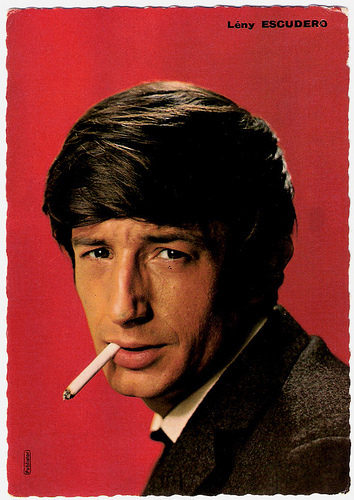
French postcard by Publistar. Photo: Henri Rzepski.
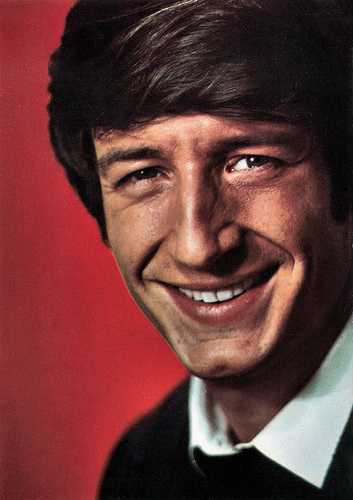
French postcard by Editions L'age des Idoles / Publistar, Marseille, no. 936. Photo: Henri Rzepski.
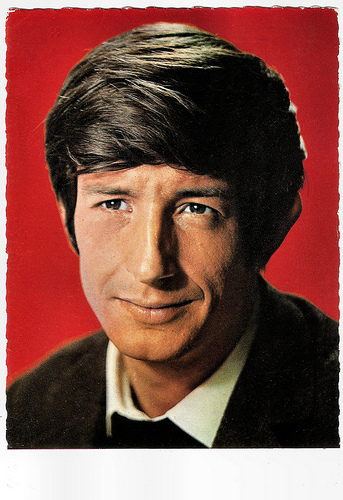
French postcard by Editions Publistar, Marseille, no. 813. Photo: Henri Rzepski.
Success, Celebrity and Fortune
Leny Escudéro was born as Joaquim Leni Escudero in 1932 in Espinal, Spain. His parents were Spanish republicans, who left their country that was destroyed by the civil war of 1939. They went to live in Paris, where they met hard times.
After some odd jobs Leny started his singing career in 1957. In 1962 he made his first record, Pour une amourette, which brought immediate success, celebrity and fortune. He detested stardom and left for a long world tour to South America, the Middle East, the United States, Russia and Africa.
Escudéro was a singer/songwriter with a very characteristic voice, which is captivating, emotional and very sincere. Between 1970 and 1990 he sang about actual, socially important subjects. His themes are the Spanish war, dictatorships, and how maltreated many people on our planet are.
His album Escudero 71 received the Grand prix of the Académie Charles Cros. Among his most beautiful and poetic chansons is Ballade à Sylvie, and he was also well known as singer of Lily Marlene.
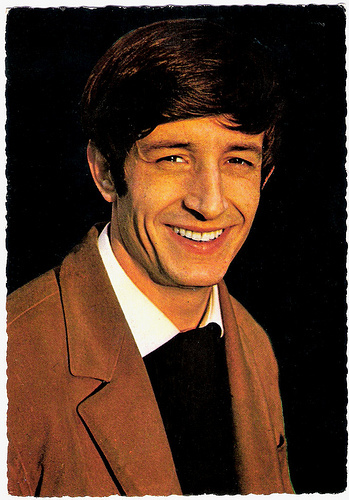
French postcard by Editions Publistar, Marseille, no. 769. Photo: Henri Rzepski.

French postcard by E.D.U.G., no. 294. Photo: Herman Leonard.
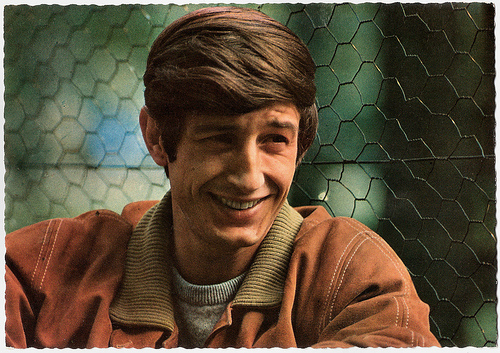
French postcard by Publistar, Marseille, no. 1251. Photo: Laguens / Polydor.
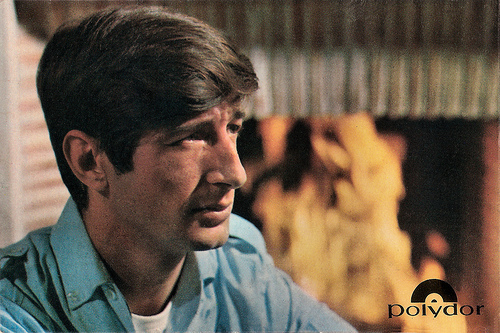
French promotion card by Polydor.
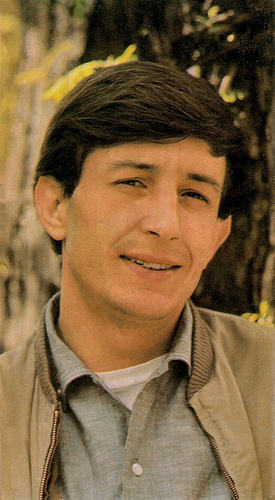
Belgian postcard by S. Best, Anvers (Antwerp), no. 25. Gift card for Victoria chocolates.
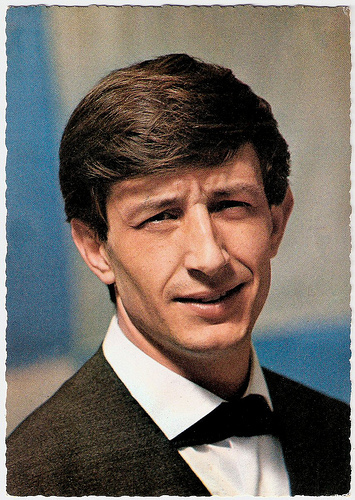
French postcard by E.D.U.G., Marseille, no. 295. Photo: Herman Leonard / BelAir.
Gypsy
Since the 1970s Leny Escudéro was also active as an actor. In 1973 he appeared in the TV film Babeau (Philipe Bordier, 1973), for which he also composed the score.
Later followed films like the political thriller La femme flic/The Woman Cop (Yves Boisset, 1980) starring Miou-Miou, Rouget le braconnier (Gilles Cousin, 1989), Le dénommé/No Time for Justice (Jean-Claude Dague, 1990), and a few TV series.
In these films Leny Escudéro often played an immigrant or a gypsy. His father was actually a gypsy. In 2015, he published his autobiography, Ma vie n'a pas commencé.
He was married to Celeste Bettencourt Escudero. They had three children, Christine, Stéfany and Julian. The latter accompanied his father on the guitar during his concerts and wrote the music for several of his songs. Two of his eight grandchildren later also accompanied him on the guitar.
Leny Escudéro died on 9 October 2015 at his home in Giverny, near Vernon in France, as a result of acute lung failure.
Live performance of Pour une amourette. Source: Ina Chansons (YouTube).
Live performance of Si tu es reine. Source: Ina Chansons (YouTube).
Leny Escudéro performing at the Olympia in 2007, accompanied by his grandchildren. Source: ClarisseCaterino (YouTube).
Sources: Leny Escudero-Le Site Officiel (French), Marc Dzalba-Lyndis (Leny Escudero, chanteur de la liberté - French), Wikipedia (French), and .

French postcard by Publistar. Photo: Henri Rzepski.

French postcard by Editions L'age des Idoles / Publistar, Marseille, no. 936. Photo: Henri Rzepski.

French postcard by Editions Publistar, Marseille, no. 813. Photo: Henri Rzepski.
Success, Celebrity and Fortune
Leny Escudéro was born as Joaquim Leni Escudero in 1932 in Espinal, Spain. His parents were Spanish republicans, who left their country that was destroyed by the civil war of 1939. They went to live in Paris, where they met hard times.
After some odd jobs Leny started his singing career in 1957. In 1962 he made his first record, Pour une amourette, which brought immediate success, celebrity and fortune. He detested stardom and left for a long world tour to South America, the Middle East, the United States, Russia and Africa.
Escudéro was a singer/songwriter with a very characteristic voice, which is captivating, emotional and very sincere. Between 1970 and 1990 he sang about actual, socially important subjects. His themes are the Spanish war, dictatorships, and how maltreated many people on our planet are.
His album Escudero 71 received the Grand prix of the Académie Charles Cros. Among his most beautiful and poetic chansons is Ballade à Sylvie, and he was also well known as singer of Lily Marlene.

French postcard by Editions Publistar, Marseille, no. 769. Photo: Henri Rzepski.

French postcard by E.D.U.G., no. 294. Photo: Herman Leonard.

French postcard by Publistar, Marseille, no. 1251. Photo: Laguens / Polydor.

French promotion card by Polydor.

Belgian postcard by S. Best, Anvers (Antwerp), no. 25. Gift card for Victoria chocolates.

French postcard by E.D.U.G., Marseille, no. 295. Photo: Herman Leonard / BelAir.
Gypsy
Since the 1970s Leny Escudéro was also active as an actor. In 1973 he appeared in the TV film Babeau (Philipe Bordier, 1973), for which he also composed the score.
Later followed films like the political thriller La femme flic/The Woman Cop (Yves Boisset, 1980) starring Miou-Miou, Rouget le braconnier (Gilles Cousin, 1989), Le dénommé/No Time for Justice (Jean-Claude Dague, 1990), and a few TV series.
In these films Leny Escudéro often played an immigrant or a gypsy. His father was actually a gypsy. In 2015, he published his autobiography, Ma vie n'a pas commencé.
He was married to Celeste Bettencourt Escudero. They had three children, Christine, Stéfany and Julian. The latter accompanied his father on the guitar during his concerts and wrote the music for several of his songs. Two of his eight grandchildren later also accompanied him on the guitar.
Leny Escudéro died on 9 October 2015 at his home in Giverny, near Vernon in France, as a result of acute lung failure.
Live performance of Pour une amourette. Source: Ina Chansons (YouTube).
Live performance of Si tu es reine. Source: Ina Chansons (YouTube).
Leny Escudéro performing at the Olympia in 2007, accompanied by his grandchildren. Source: ClarisseCaterino (YouTube).
Sources: Leny Escudero-Le Site Officiel (French), Marc Dzalba-Lyndis (Leny Escudero, chanteur de la liberté - French), Wikipedia (French), and .
Published on October 10, 2015 16:30
October 9, 2015
Lon Chaney
Closing film of this year's Le Giornate del Cinema Muto in Pordenone is The Phantom of the Opera (Rupert Julian, 1925), starring Lon Chaney (1883-1930), one of the most versatile and powerful actors of early cinema. Between 1912 and 1930 he played more the 150 widely diverse roles. He is renowned for his characterizations of tortured, often grotesque and afflicted characters, and his groundbreaking artistry with makeup in such silent horror films as The Hunchback of Notre Dame (1923) and He Who Gets Slapped (1924).
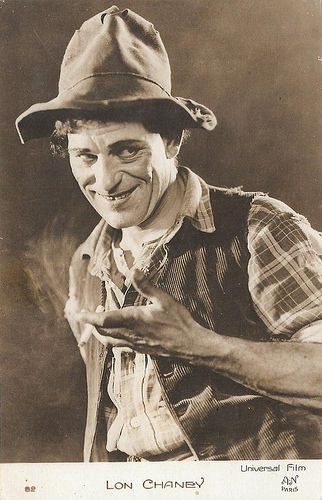
French postcard by A.N., Paris, no. 52. Photo: Universal Film. Collection: Didier Hanson.
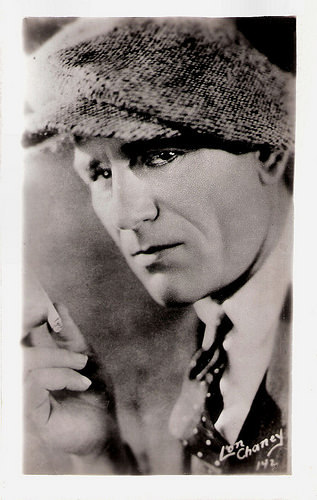
British postcard, no. 142.
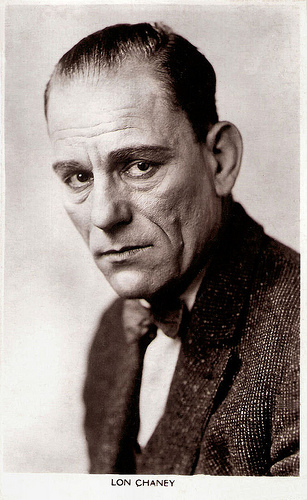
British postcard in the Picturegoer Series, London, no. 43.
Communicating through pantomime, sign language and facial expression
Leonidas Frank ‘Lon’ Chaney was born in Colorado Springs, Colorado, in 1883. He was the son of deaf mute parents, Frank and Emma Chaney, and he learned from childhood to communicate through pantomime, sign language and facial expression. The stagestruck Chaney worked in a variety of backstage positions at the opera house in his hometown of Colorado Springs. Only 17, he was eventually allowed to appear on stage.
In 1901, he went on the road as an actor in a play that he co-wrote with his brother, The Little Tycoon. After limited success, the company was sold. He began traveling with popular Vaudeville and theatre acts. On tour in Oklahoma City, he met Francis Cleveland ‘Cleva’ Creighton, (Cleva) who was auditioning for a part in the show as a singer.
In 1905, Chaney, then 22, married 16-year-old Cleva and in 1906, their only child, a son, Creighton Tull Chaney (later known as film actor Lon Chaney, Jr.) was born. The Chaneys continued touring, settling in California in 1910. Their marriage became strained due to working conditions, money and jealousy. In 1913, Cleva went to the Majestic Theater in downtown Los Angeles, where Lon was managing the Kolb and Dill show, and attempted suicide by swallowing mercuric chloride. The suicide attempt failed but it ruined her voice.
The ensuing scandal and divorce forced Chaney out of the theatre and into the booming industry of silent films. Between 1912 and 1917, Chaney worked under contract for Universal Studios doing 100 bit or character parts. His skill with makeup gained him many parts in the highly competitive casting atmosphere. During this time, Chaney befriended the husband-wife director team of Joe De Grasse and Ida May Park, who gave him substantial roles in their pictures, and further encouraged him to play macabre characters.
Chaney married one of his former colleagues in the Kolb and Dill company tour, chorus girl Hazel Hastings. Little is known of Hazel, except that her marriage to Chaney was solid. The couple gained custody of Chaney's 10-year-old son Creighton, who had resided in various homes and boarding schools since Chaney's divorce from Cleva.
In 1917 Universal presented Chaney, Dorothy Phillips, and William Stowell as a team in the drama The Piper's Price (Joe De Grasse, 1917). In succeeding films, the men alternated playing lover, villain, or other man to the beautiful Phillips. They would occasionally be joined by Claire Du Brey nearly making the trio a quartet of recurring actors from film to film. So successful were the films starring this group that Universal produced fourteen films from 1917 to 1919 with Chaney, Stowell, and Phillips.
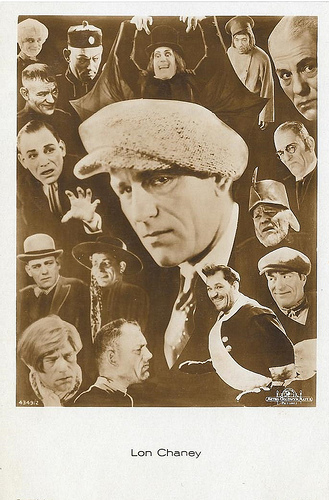
German postcard by Ross Verlag, no. 4349/2, 1929-1930. Image: MGM. Collection: Didier Hanson.
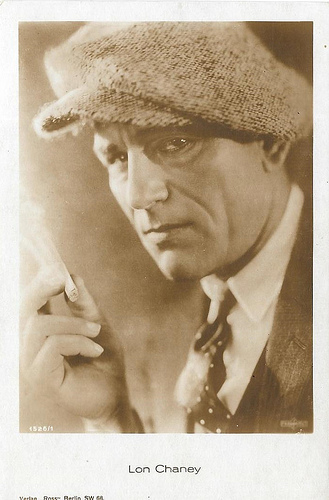
German postcard by Ross Verlag, no. 1526/1, 1927-1928. Photo: Fanumet. Collection: Didier Hanson.
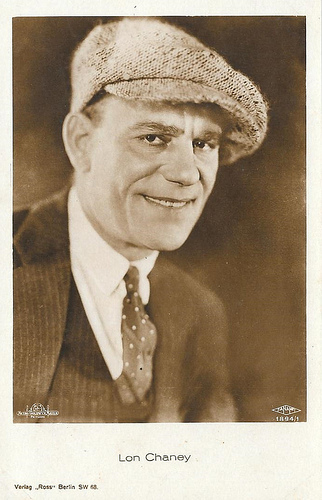
German postcard by Ross Verlag, no. 1894/1, 1927-1928. Photo: MGM / FaNuMet. Collection: Didier Hanson.
A con man who pretends to be cripple and is miraculously healed
By 1917 Lon Chaney was a prominent actor of the Universal studio, but his salary did not reflect this status. When Chaney asked for a raise, studio executive William Sistrom replied, "You'll never be worth more than one hundred dollars a week." After leaving the studio, Chaney struggled for the first year as a free-lance character actor.
He got his first big break when playing a substantial role in William S. Hart's Western, Riddle Gawne (William S. Hart, Lambert Hillyer, 1918). He received high praise for his performance in the role. In 1919, Chaney had another breakthrough performance in The Miracle Man (George Loane Tucker, 1919), as The Frog, a con man who pretends to be cripple and is miraculously healed. The film displayed not only Chaney's acting ability, but also his talent as a master of makeup. Critical praise and a gross of over $2 million put Chaney on the map as America's foremost character actor.
He exhibited great adaptability with makeup in more conventional crime and adventure films, such as The Penalty (Wallace Worsley, 1920), in which he played an amputee gangster. As Quasimodo in The Hunchback of Notre Dame (Wallace Worsley, 1923) and Erik, the tortured opera ghost in The Phantom of the Opera (Rupert Julian, 1925), Chaney created two of the most grotesquely deformed characters in film history.
William K. Everson in American Silent Film : "Only 'The Phantom of the Opera,' with its classic unmasking scene, a masterpiece of manipulative editing, really succeeded (and still does!) in actually scaring the audience - and that because the revelation had to be a purely visual one. Moreover, Lon Chaney's make-up was so grotesque as to equal, if not surpass, anything that the audience might have anticipated or imagined."
Chaney also appeared in ten films directed by Tod Browning, often portraying disguised and/or mutilated characters. His portrayals sought to elicit a degree of sympathy and pathos among viewers not overwhelmingly terrified or repulsed by the monstrous disfigurements of these victims of fate.
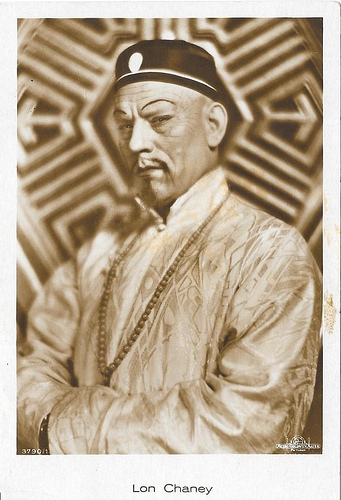
German postcard by Ross Verlag, no. 3790/1, 1928-1929. Photo: MGM. Publicity still for Mr. Wu (1927). Collection: Didier Hanson.
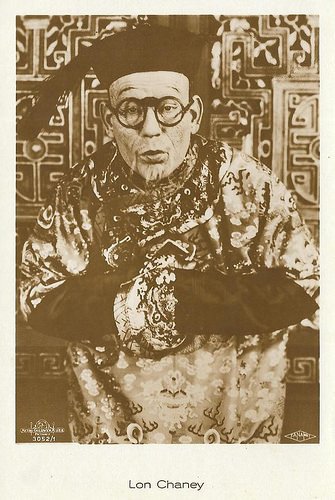
German postcard by Ross Verlag, no. 3052/1, 1928-1929. Photo: MGM / Fanumet. Publicity still for Mr. Wu (1927). Collection: Didier Hanson.
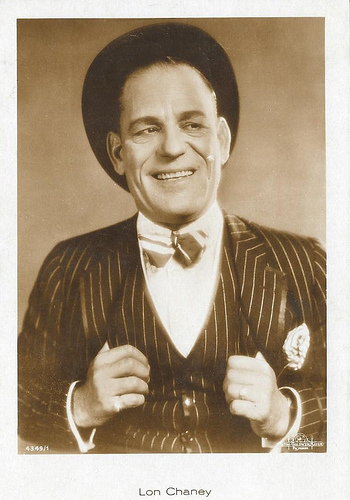
German postcard by Ross Verlag, no. 4349/1, 1929-1930. Photo: MGM. Publicity still for The Unholy Three (Jack Conway, 1930). Collection: Didier Hanson.
One of the most legendary and sought after lost films
In 1924, Lon Chaney starred in Metro-Goldwyn’s He Who Gets Slapped, a circus melodrama voted one of the best films of the year. The success of this film led to a series of contracts with MGM Studios for the next five years. In these final five years of his film career, Chaney gave some of his most memorable performances.
His portrayal of a tough-as-nails marine drill instructor opposite William Haines in Tell It to the Marines (George W. Hill, 1926), one of his favorite films, earned him the affection of the Marine Corps, who made him their first honorary member from the motion picture industry. Memorable is also his carnival knife-thrower Alonzo the Armless in The Unknown (Tod Browning, 1927) opposite Joan Crawford.
In 1927, Chaney also co-starred with Conrad Nagel and Marceline Day in the horror film London After Midnight (Tod Browning, 1927), considered as one of the most legendary and sought after lost films. His final film role was a sound remake of his silent classic The Unholy Three (Jack Conway, 1930). He played Echo, a crook ventriloquist and used five different voices (the ventriloquist, the old woman, a parrot, the dummy and the girl) in the film, thus proving he could make the transition from silent films to the talkies. Chaney signed a sworn statement declaring that the five voices in the film were his own.
During the filming of Thunder in the winter of 1929, Chaney developed pneumonia. In late 1929 the heavy smoker was diagnosed with bronchial lung cancer. This was exacerbated when artificial snow, made out of cornflakes, lodged in his throat during filming and quickly created a serious infection. Despite aggressive treatment, his condition gradually worsened, and seven weeks after the release of the remake of The Unholy Three (1930), he died of a throat hemorrhage in Los Angeles, California.
In his last days, his illness had rendered him unable to speak, forcing him to rely on the pantomimic gestures of his youth in order to communicate with his friends and loved ones. Chaney and his second wife Hazel had led a discreet private life distant from the Hollywood social scene. Chaney did minimal promotional work for his films and for Metro-Goldwyn-Mayer, purposefully fostering a mysterious image, and he reportedly intentionally avoided the social scene in Hollywood.
At the end of the 1950s Lon Chaney was rediscovered. He was portrayed by James Cagney in the biopic Man of a Thousand Faces (Joseph Pevney, 1957). In 1958, Chaney fan Forrest J. Ackerman started and edited the magazine Famous Monsters of Filmland, which published many photographs and articles about Chaney. Ackerman is also present in Kevin Brownlow’s documentary Lon Chaney: A Thousand Faces (2000).
The famous unmasking scene in The Phantom of the Opera (Rupert Julian, 1925). Source: Adlerangriffe (YouTube).
Sources: Hal Erickson (AllMovie), Lon Chaney.com, Silents are Golden, Wikipedia and .

French postcard by A.N., Paris, no. 52. Photo: Universal Film. Collection: Didier Hanson.

British postcard, no. 142.

British postcard in the Picturegoer Series, London, no. 43.
Communicating through pantomime, sign language and facial expression
Leonidas Frank ‘Lon’ Chaney was born in Colorado Springs, Colorado, in 1883. He was the son of deaf mute parents, Frank and Emma Chaney, and he learned from childhood to communicate through pantomime, sign language and facial expression. The stagestruck Chaney worked in a variety of backstage positions at the opera house in his hometown of Colorado Springs. Only 17, he was eventually allowed to appear on stage.
In 1901, he went on the road as an actor in a play that he co-wrote with his brother, The Little Tycoon. After limited success, the company was sold. He began traveling with popular Vaudeville and theatre acts. On tour in Oklahoma City, he met Francis Cleveland ‘Cleva’ Creighton, (Cleva) who was auditioning for a part in the show as a singer.
In 1905, Chaney, then 22, married 16-year-old Cleva and in 1906, their only child, a son, Creighton Tull Chaney (later known as film actor Lon Chaney, Jr.) was born. The Chaneys continued touring, settling in California in 1910. Their marriage became strained due to working conditions, money and jealousy. In 1913, Cleva went to the Majestic Theater in downtown Los Angeles, where Lon was managing the Kolb and Dill show, and attempted suicide by swallowing mercuric chloride. The suicide attempt failed but it ruined her voice.
The ensuing scandal and divorce forced Chaney out of the theatre and into the booming industry of silent films. Between 1912 and 1917, Chaney worked under contract for Universal Studios doing 100 bit or character parts. His skill with makeup gained him many parts in the highly competitive casting atmosphere. During this time, Chaney befriended the husband-wife director team of Joe De Grasse and Ida May Park, who gave him substantial roles in their pictures, and further encouraged him to play macabre characters.
Chaney married one of his former colleagues in the Kolb and Dill company tour, chorus girl Hazel Hastings. Little is known of Hazel, except that her marriage to Chaney was solid. The couple gained custody of Chaney's 10-year-old son Creighton, who had resided in various homes and boarding schools since Chaney's divorce from Cleva.
In 1917 Universal presented Chaney, Dorothy Phillips, and William Stowell as a team in the drama The Piper's Price (Joe De Grasse, 1917). In succeeding films, the men alternated playing lover, villain, or other man to the beautiful Phillips. They would occasionally be joined by Claire Du Brey nearly making the trio a quartet of recurring actors from film to film. So successful were the films starring this group that Universal produced fourteen films from 1917 to 1919 with Chaney, Stowell, and Phillips.

German postcard by Ross Verlag, no. 4349/2, 1929-1930. Image: MGM. Collection: Didier Hanson.

German postcard by Ross Verlag, no. 1526/1, 1927-1928. Photo: Fanumet. Collection: Didier Hanson.

German postcard by Ross Verlag, no. 1894/1, 1927-1928. Photo: MGM / FaNuMet. Collection: Didier Hanson.
A con man who pretends to be cripple and is miraculously healed
By 1917 Lon Chaney was a prominent actor of the Universal studio, but his salary did not reflect this status. When Chaney asked for a raise, studio executive William Sistrom replied, "You'll never be worth more than one hundred dollars a week." After leaving the studio, Chaney struggled for the first year as a free-lance character actor.
He got his first big break when playing a substantial role in William S. Hart's Western, Riddle Gawne (William S. Hart, Lambert Hillyer, 1918). He received high praise for his performance in the role. In 1919, Chaney had another breakthrough performance in The Miracle Man (George Loane Tucker, 1919), as The Frog, a con man who pretends to be cripple and is miraculously healed. The film displayed not only Chaney's acting ability, but also his talent as a master of makeup. Critical praise and a gross of over $2 million put Chaney on the map as America's foremost character actor.
He exhibited great adaptability with makeup in more conventional crime and adventure films, such as The Penalty (Wallace Worsley, 1920), in which he played an amputee gangster. As Quasimodo in The Hunchback of Notre Dame (Wallace Worsley, 1923) and Erik, the tortured opera ghost in The Phantom of the Opera (Rupert Julian, 1925), Chaney created two of the most grotesquely deformed characters in film history.
William K. Everson in American Silent Film : "Only 'The Phantom of the Opera,' with its classic unmasking scene, a masterpiece of manipulative editing, really succeeded (and still does!) in actually scaring the audience - and that because the revelation had to be a purely visual one. Moreover, Lon Chaney's make-up was so grotesque as to equal, if not surpass, anything that the audience might have anticipated or imagined."
Chaney also appeared in ten films directed by Tod Browning, often portraying disguised and/or mutilated characters. His portrayals sought to elicit a degree of sympathy and pathos among viewers not overwhelmingly terrified or repulsed by the monstrous disfigurements of these victims of fate.

German postcard by Ross Verlag, no. 3790/1, 1928-1929. Photo: MGM. Publicity still for Mr. Wu (1927). Collection: Didier Hanson.

German postcard by Ross Verlag, no. 3052/1, 1928-1929. Photo: MGM / Fanumet. Publicity still for Mr. Wu (1927). Collection: Didier Hanson.

German postcard by Ross Verlag, no. 4349/1, 1929-1930. Photo: MGM. Publicity still for The Unholy Three (Jack Conway, 1930). Collection: Didier Hanson.
One of the most legendary and sought after lost films
In 1924, Lon Chaney starred in Metro-Goldwyn’s He Who Gets Slapped, a circus melodrama voted one of the best films of the year. The success of this film led to a series of contracts with MGM Studios for the next five years. In these final five years of his film career, Chaney gave some of his most memorable performances.
His portrayal of a tough-as-nails marine drill instructor opposite William Haines in Tell It to the Marines (George W. Hill, 1926), one of his favorite films, earned him the affection of the Marine Corps, who made him their first honorary member from the motion picture industry. Memorable is also his carnival knife-thrower Alonzo the Armless in The Unknown (Tod Browning, 1927) opposite Joan Crawford.
In 1927, Chaney also co-starred with Conrad Nagel and Marceline Day in the horror film London After Midnight (Tod Browning, 1927), considered as one of the most legendary and sought after lost films. His final film role was a sound remake of his silent classic The Unholy Three (Jack Conway, 1930). He played Echo, a crook ventriloquist and used five different voices (the ventriloquist, the old woman, a parrot, the dummy and the girl) in the film, thus proving he could make the transition from silent films to the talkies. Chaney signed a sworn statement declaring that the five voices in the film were his own.
During the filming of Thunder in the winter of 1929, Chaney developed pneumonia. In late 1929 the heavy smoker was diagnosed with bronchial lung cancer. This was exacerbated when artificial snow, made out of cornflakes, lodged in his throat during filming and quickly created a serious infection. Despite aggressive treatment, his condition gradually worsened, and seven weeks after the release of the remake of The Unholy Three (1930), he died of a throat hemorrhage in Los Angeles, California.
In his last days, his illness had rendered him unable to speak, forcing him to rely on the pantomimic gestures of his youth in order to communicate with his friends and loved ones. Chaney and his second wife Hazel had led a discreet private life distant from the Hollywood social scene. Chaney did minimal promotional work for his films and for Metro-Goldwyn-Mayer, purposefully fostering a mysterious image, and he reportedly intentionally avoided the social scene in Hollywood.
At the end of the 1950s Lon Chaney was rediscovered. He was portrayed by James Cagney in the biopic Man of a Thousand Faces (Joseph Pevney, 1957). In 1958, Chaney fan Forrest J. Ackerman started and edited the magazine Famous Monsters of Filmland, which published many photographs and articles about Chaney. Ackerman is also present in Kevin Brownlow’s documentary Lon Chaney: A Thousand Faces (2000).
The famous unmasking scene in The Phantom of the Opera (Rupert Julian, 1925). Source: Adlerangriffe (YouTube).
Sources: Hal Erickson (AllMovie), Lon Chaney.com, Silents are Golden, Wikipedia and .
Published on October 09, 2015 22:00
October 8, 2015
Grit Haid
Today at Le Giornate del Cinema Muto in Pordenone, I am gonna see another film starring forzuto Luciano Albertini, the German adventure film Rinaldo Rinaldini (1927). Leading lady is Austrian film actress Grit Haid (1900-1938), who was active in the Austrian and German cinema from the mid-1910s to the 1930s.
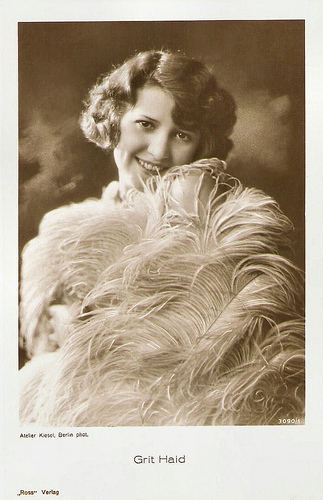
German postcard by Ross Verlag, no. 3090/1, 1928-1929. Photo: Atelier Kiesel, Berlin.
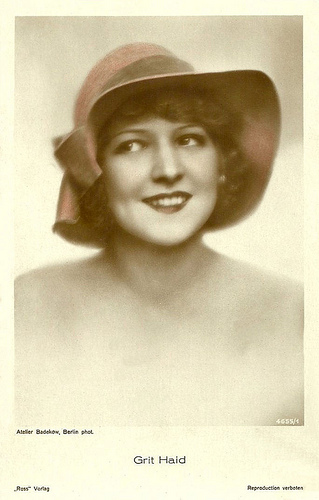
German postcard by Ross Verlag, no. 4655/1, 1929-1930. Photo: Atelier Badekow, Berlin.
Wiener Mädel
Grit Haid was born as Margarete Haid in Vienna, Austria-Hungary (now Austria) in 1900. She was the sister of film star Liane Haid . Grit did ballet classes and became solo dancer at the Viennese Volksoper.
Already at a young age she started her film career. Her first film was Fürst Seppl/Prince Seppl (Carl Froelich, 1915). Soon she was typecasted as the typical merry Wiener Mädel. After the First World War she worked a.o. for the Viennese Filmag.
Grit Haid mainly played in comedies, sometimes also in dramas, and from 1926 on she also appeared in German films.
It was then that her career really set off, with such films as Der Soldat der Marie/Marie's Soldier (Erich Schönfelder, 1926) starring Xenia Desni , Menschen untereinander/People Among Another (Gerhard Lamprecht, 1926) starring Alfred Abel , and Der Mann ohne Kopf/The Man Without A Head (Nunzio Malasomma, 1927) starring Carlo Aldini .
One of her most enjoyable film was the romantic adventure film Rinaldo Rinaldini (Max Obal, Rudolf Dworsky, 1927), featuring Italian strong man Luciano Albertini.
She also appeared in Der alte Fritz/The Old Fritz (Gerhard Lamprecht, 1927) starring Otto Gebühr , Saxophon-Susi (Carl Lamac, 1928) starring Anny Ondra , Sein bester Freund/His Best Friend (Harry Piel, 1929) and Andreas Hofer (Hans Prechtl, 1929), starring Fritz Greiner.
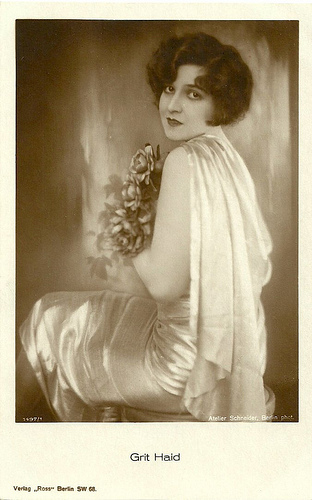
German postcard by Ross Verlag, no. 1497/1, 1927-1928. Photo: Atelier Schneider, Berlin.
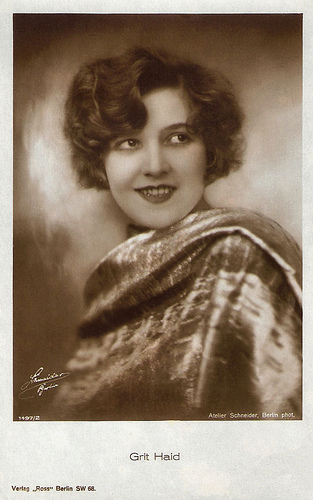
German postcard by Ross Verlag, no. 1497/2, 1927-1928. Photo: Atelier Schneider, Berlin.
Plane Crash
Grit Haid also played in two of the adventure films that serial film hero Eddy Polo made in Germany in the late 1920s: Der gefesselte Polo/The Chained Polo (Léo Lasko, 1928) and Eddy Polo im Wespennest/Eddy Polo in the wasps' nest (Léo Lasko, 1930).
In the meantime Haid had also remained engaged at Berlin and Viennese theaters and during the 1926-1927 season she performed under Max Reinhardt’s direction as Fräulein Roboz in Ferenc Molnár’s one act play Das Veilchen (The violet), as well as Nannie in W. Somerset Maugham’s Viktoria.
In the 1930s Grit Haid mostly became small parts, but she had a leading part in the sound remake of her first film Fürst Seppl/Prince Seppl (Franz Osten, 1932). During her career, Haid played in some 50 films.
Gritt Haid died tragically during a plane crash in the Schwarzwald in 1938. She was married to scriptwriter Jozef (later: Joseph) Than, who had written Fürst Seppl/Prince Seppl.
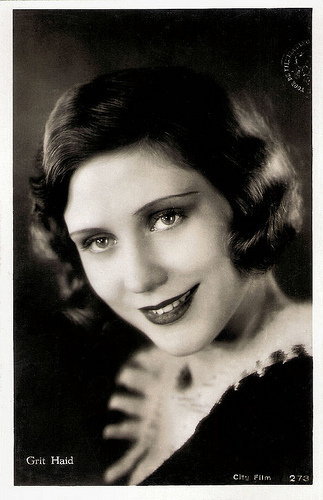
Dutch postcard by City Film, no. 273.
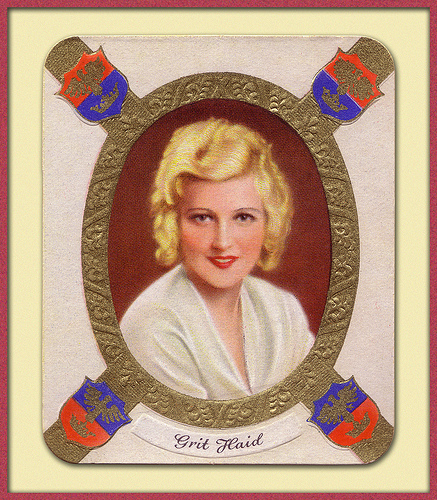
German collectors card. Collection: Gerd Scheller@Flickr.
This is a post for Postcard Friendship Friday, hosted by Beth at the blog The Best Hearts are Crunchy. You can visit her by clicking on the button below.

Sources: Thomas Staedeli (Cyranos), Wikipedia (German), and .

German postcard by Ross Verlag, no. 3090/1, 1928-1929. Photo: Atelier Kiesel, Berlin.

German postcard by Ross Verlag, no. 4655/1, 1929-1930. Photo: Atelier Badekow, Berlin.
Wiener Mädel
Grit Haid was born as Margarete Haid in Vienna, Austria-Hungary (now Austria) in 1900. She was the sister of film star Liane Haid . Grit did ballet classes and became solo dancer at the Viennese Volksoper.
Already at a young age she started her film career. Her first film was Fürst Seppl/Prince Seppl (Carl Froelich, 1915). Soon she was typecasted as the typical merry Wiener Mädel. After the First World War she worked a.o. for the Viennese Filmag.
Grit Haid mainly played in comedies, sometimes also in dramas, and from 1926 on she also appeared in German films.
It was then that her career really set off, with such films as Der Soldat der Marie/Marie's Soldier (Erich Schönfelder, 1926) starring Xenia Desni , Menschen untereinander/People Among Another (Gerhard Lamprecht, 1926) starring Alfred Abel , and Der Mann ohne Kopf/The Man Without A Head (Nunzio Malasomma, 1927) starring Carlo Aldini .
One of her most enjoyable film was the romantic adventure film Rinaldo Rinaldini (Max Obal, Rudolf Dworsky, 1927), featuring Italian strong man Luciano Albertini.
She also appeared in Der alte Fritz/The Old Fritz (Gerhard Lamprecht, 1927) starring Otto Gebühr , Saxophon-Susi (Carl Lamac, 1928) starring Anny Ondra , Sein bester Freund/His Best Friend (Harry Piel, 1929) and Andreas Hofer (Hans Prechtl, 1929), starring Fritz Greiner.

German postcard by Ross Verlag, no. 1497/1, 1927-1928. Photo: Atelier Schneider, Berlin.

German postcard by Ross Verlag, no. 1497/2, 1927-1928. Photo: Atelier Schneider, Berlin.
Plane Crash
Grit Haid also played in two of the adventure films that serial film hero Eddy Polo made in Germany in the late 1920s: Der gefesselte Polo/The Chained Polo (Léo Lasko, 1928) and Eddy Polo im Wespennest/Eddy Polo in the wasps' nest (Léo Lasko, 1930).
In the meantime Haid had also remained engaged at Berlin and Viennese theaters and during the 1926-1927 season she performed under Max Reinhardt’s direction as Fräulein Roboz in Ferenc Molnár’s one act play Das Veilchen (The violet), as well as Nannie in W. Somerset Maugham’s Viktoria.
In the 1930s Grit Haid mostly became small parts, but she had a leading part in the sound remake of her first film Fürst Seppl/Prince Seppl (Franz Osten, 1932). During her career, Haid played in some 50 films.
Gritt Haid died tragically during a plane crash in the Schwarzwald in 1938. She was married to scriptwriter Jozef (later: Joseph) Than, who had written Fürst Seppl/Prince Seppl.

Dutch postcard by City Film, no. 273.

German collectors card. Collection: Gerd Scheller@Flickr.
This is a post for Postcard Friendship Friday, hosted by Beth at the blog The Best Hearts are Crunchy. You can visit her by clicking on the button below.

Sources: Thomas Staedeli (Cyranos), Wikipedia (German), and .
Published on October 08, 2015 22:00
October 7, 2015
Bébé a.k.a. René Dary
We're having a wonderful time, here in Italy at Le Giornate del Cinema Muto in Pordenone. One of the youngest stars whose work is shown here was Clément Mary (1905-1974). As Bébé, he was the best known child actor of the early 1910s. He would later act in French sound films as René Dary.
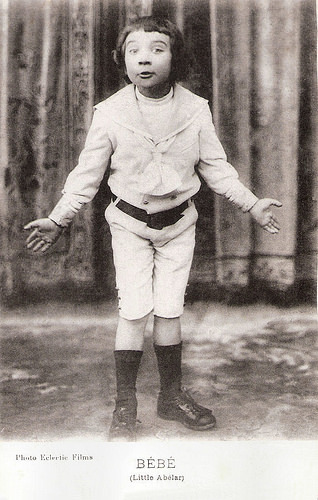
French postcard. Photo: Eclectic Films.
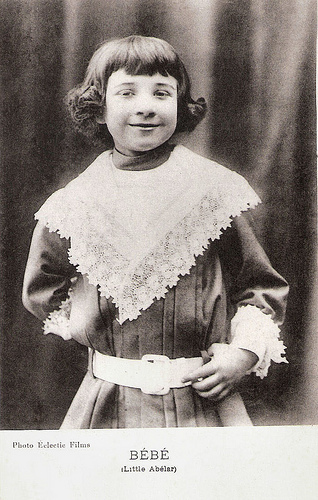
French postcard. Photo Eclectic Films.
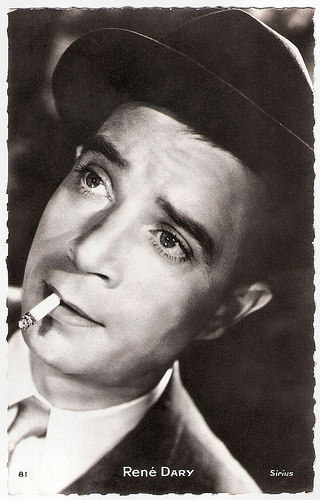
French postcard by Edit. Chantal, Rueil, no. 81. Photo: Sirius.
A spoiled brat with impossible tantrums
A few years before Bout-de-Zan ( René Poyen ), on whom we previously published on this site, Gaumont already had a very popular child actor, called Bébé. The actor behind the character had quite a story. Maxime Braquet wrote about it on the French site La ville des gens, but we also used other sources for this bio.
Anatole Clément Mary, as was Bébé's original name, was born in 1905 in Paris. He got his chance in the Spring of 1910 when he was only five. His father Abélard Mary had put in his head to go and promote himself and his two young kids as extras at the Gaumont studio.
Mary, who had been an actor, had become a rundown clown in bars because of his gambling and kept things going with some furniture trade. He had set his hopes for his kids, and gambled well this time, as they were all hired for a peplum, Les Derniers Jours de Babylone/The Last Days of Babylon.
Maxime Braquet: “Young Clément’s native playfulness, his histrionic acting making him older than he was, his borrowed street talk, and his ease on the set to charm everyone, from actors to technicians, soon began to attract the attention of producer-director Louis Feuillade.”
Feuillade tested him and designed a whole series around him, the Bébé series. All in all Clément Mary would play in 74 Bébé comedies between 1910 and 1912, according to Braquet (76 between December 1910 and February 1913, according to Francis Lacassin in Pour une contre-histoire du cinema, while IMDb lists 73 titles), such as Bébé apache (Louis Feuillade, 1910), Napoléon, Bébé et les cosaques (Louis Feuillade, 1912), Bébé en Maroc (Louis Feuillade, 1912), etc.
Lacassin writes that Feuillade permitted little Mary to do anything forbidden at home. Often his character would be a spoiled brat, have impossible tantrums and pester all adults around him, but he could also help children and old people in distress, showing his good heart after all. Often his mother would be played by Renée Carl, a leading Gaumont actress in her own. And often the child was placed in adult situations, as millionaire, marriage candidate or underworld ‘apache’. For over two years Bébé was the best known child actor worldwide.
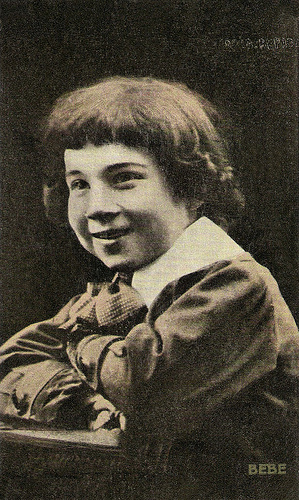
Spanish postcard in the Series Principales Artistas Cinematograficos, Serie 1a, no. 29, by Chocolate Amattler Marca Luna.
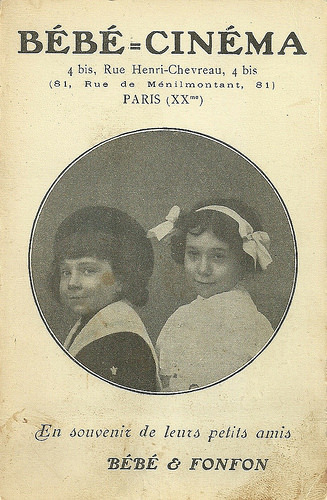
French postcard for the Bébé-Cinéma, at Paris, 4,bis, rue Henri Chevreau, in the quarter of Ménilmontant. The cinema already existed as Etoile Cinéma from 1909. On 17 January 1913 the cinema was inaugurated. When he wasn't shooting little Bébé and his sister Fonfon would come on stage, to the joy of the locals. His father tried to buy all the films of his son. It was no success. In July 1913 the cinema was resold a few times, and continued a modest life as Modern Ciné and Trianon until 1933.
The downfall of Bébé
The extremely good box office of his son's films made papa Mary wealthy too, but his money hunger would cause the downfall of his son.
Abélard bought a small cinema in Ménilmontant and called it Bébé-Cinéma, counting on a franchise by Gaumont to show his son’s films. This was the limit for Feuillade, who was already fed up with the pretense of the father’s self-promotion as his son’s manager and his continuous demands for raises for his son.
Besides, Clément was reaching an age where his cuteness as child actor was passing. Already mid-1912 another young kid, René Poyen , had been picked up in Belleville, near the studios, and had started as supporting actor to Clément in the film Bébé adopte un petit frère/Bébé adopts a lttle brother (Louis Feuillade, 1912). Bout-de-Zan replaced Bébé completely in March 1913 (February 1913, according to Francis Lacassin.
Abélard went to court against Gaumont. The court ruled that the breach of contract was just, but also that Mary was allowed to continue acting as Bébé at Pathé’s subsidiary Eclectic Films, and he did so until 1916.
Yet, it was no competition for Gaumont’s Bout-de-Zan. As David Robinson mentions in The Encyclopedia of Early Cinema, Bout-de-Zan was more plebeian while Bébé was ‘au fond’ bourgeois as type. Still, in the end René Poyen did some 50 films for Gaumont, less than Mary.
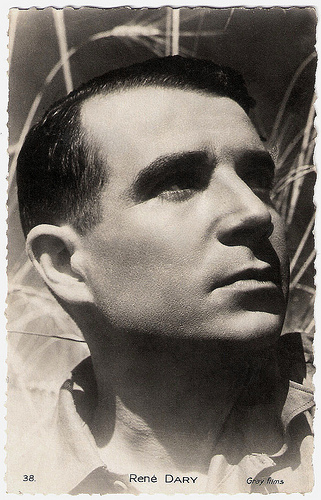
French postcard by Editions E.C., Paris, no. 38. Photo: Gray Films.
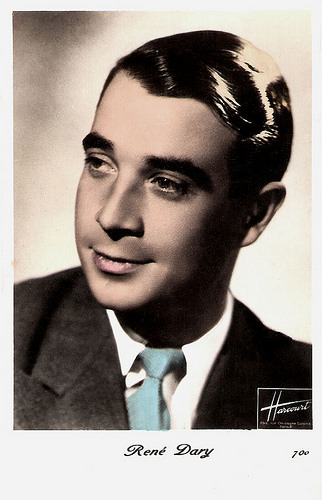
French postcard, no. 700. Photo: Studio Harcourt.
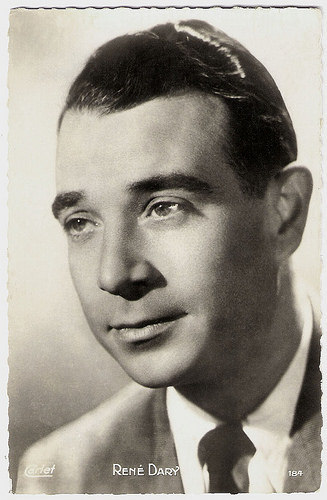
French postcard by Editions P.I., Paris, no. 184. Photo: Carlet.
Back in the spotlight
As a young man, Clément Mary tried professional boxing but acting stuck in his blood, so he took acting lessons with Lucien Guitry and joined stage tours under the name of René Duclos. Harry Baur advised him to focus on Paris, where he acted in the operetta Pour ton Bonheur, and in Les trois valses with Pierre Fresnay and Yvonne Printemps .
In 1934 he debuted in French sound cinema with bit parts, e.g. in Le Train de 8:47/The train of 8:47 (Henry Wulschleger, 1934), starring Fernandel . Director Jean-Benoit Lévy convinced him to change his name again, now to René Dary.
His role of the anarchist sailor in Le Révolte/The Rebel (1938) by Léon Mathot finally put him back in the spotlight. Dary then specialized in tough, taciturn sailors who under outside brawling hid true generosity, in films like Nord-Atlantique/North Atlantic (Maurice Cloche, 1939), Le Café du port/The harbour café (Jean Choux, 1940), Forte Tête (Léon Mathot, 1942), and À la belle frégate/At the beautiful frigate (Albert Valentin, 1943) with Michèle Alfa .
During the war, René Dary peaked as the bad boy repented in Le carrefour des enfants perdus/Crossroads of the Lost Children (Léo Joannon, 1944). Dary was also the first to embody for the cinema the character of Nestor Burma, the famous shock detective imagined by novelist Léo Malet. He portrayed Burma in the film 120, Quai de la Gare (Jacques Daniel-Norman, 1943) with Sophie Desmarets and Jean Parédès.
After that his popularity as film actor declined, apart from his part of Riton, the friend of Max ( Jean Gabin ), in Touchez pas au grisbi!/Hands Off the Loot (Jacques Becker, 1954). Dary continued to act on stage and was quite successful there in the 1960s. He also acted in television dramas, and wrote a novel, Express 407.
Clément Mary a.k.a. Bébé a.k.a. René Dary died in 1974 in Plan-de-Cuques (Bouche-du-Rhône), France.
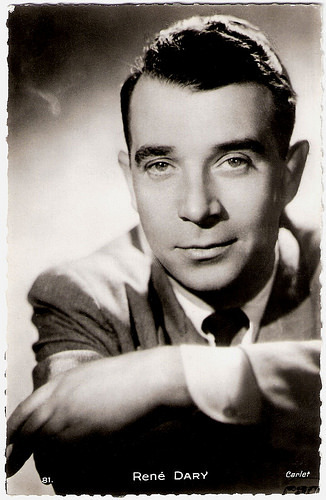
French postcard by Editions E.C., no. 81. Photo: Carlet.
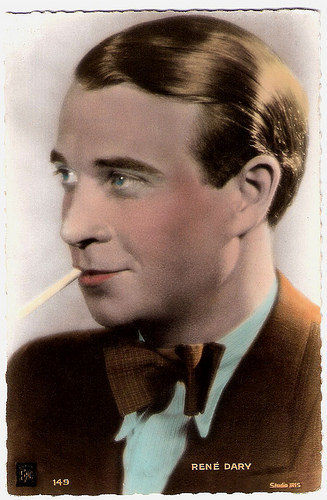
French postcard by Editions et Publications Cinematographiques (EPC), no. 149. Photo: Studio Iris.
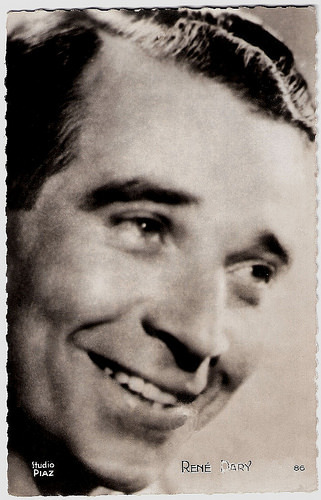
French postcard by Editions P.I., Paris, no. 86. Photo: Studio Piaz.
Sources: David Robinson (The Encyclopedia of Early Cinema), Francis Lacassin (Pour une contre-histoire du cinema - French), Jean-Jacques Meusy (Paris-Palaces ou le temps des cinémas - 1894-1918 - French), Maxime Braquet (Les aventures de Bébé et Bout-de-Zan - La ville des gens - French), and IMDb.

French postcard. Photo: Eclectic Films.

French postcard. Photo Eclectic Films.

French postcard by Edit. Chantal, Rueil, no. 81. Photo: Sirius.
A spoiled brat with impossible tantrums
A few years before Bout-de-Zan ( René Poyen ), on whom we previously published on this site, Gaumont already had a very popular child actor, called Bébé. The actor behind the character had quite a story. Maxime Braquet wrote about it on the French site La ville des gens, but we also used other sources for this bio.
Anatole Clément Mary, as was Bébé's original name, was born in 1905 in Paris. He got his chance in the Spring of 1910 when he was only five. His father Abélard Mary had put in his head to go and promote himself and his two young kids as extras at the Gaumont studio.
Mary, who had been an actor, had become a rundown clown in bars because of his gambling and kept things going with some furniture trade. He had set his hopes for his kids, and gambled well this time, as they were all hired for a peplum, Les Derniers Jours de Babylone/The Last Days of Babylon.
Maxime Braquet: “Young Clément’s native playfulness, his histrionic acting making him older than he was, his borrowed street talk, and his ease on the set to charm everyone, from actors to technicians, soon began to attract the attention of producer-director Louis Feuillade.”
Feuillade tested him and designed a whole series around him, the Bébé series. All in all Clément Mary would play in 74 Bébé comedies between 1910 and 1912, according to Braquet (76 between December 1910 and February 1913, according to Francis Lacassin in Pour une contre-histoire du cinema, while IMDb lists 73 titles), such as Bébé apache (Louis Feuillade, 1910), Napoléon, Bébé et les cosaques (Louis Feuillade, 1912), Bébé en Maroc (Louis Feuillade, 1912), etc.
Lacassin writes that Feuillade permitted little Mary to do anything forbidden at home. Often his character would be a spoiled brat, have impossible tantrums and pester all adults around him, but he could also help children and old people in distress, showing his good heart after all. Often his mother would be played by Renée Carl, a leading Gaumont actress in her own. And often the child was placed in adult situations, as millionaire, marriage candidate or underworld ‘apache’. For over two years Bébé was the best known child actor worldwide.

Spanish postcard in the Series Principales Artistas Cinematograficos, Serie 1a, no. 29, by Chocolate Amattler Marca Luna.

French postcard for the Bébé-Cinéma, at Paris, 4,bis, rue Henri Chevreau, in the quarter of Ménilmontant. The cinema already existed as Etoile Cinéma from 1909. On 17 January 1913 the cinema was inaugurated. When he wasn't shooting little Bébé and his sister Fonfon would come on stage, to the joy of the locals. His father tried to buy all the films of his son. It was no success. In July 1913 the cinema was resold a few times, and continued a modest life as Modern Ciné and Trianon until 1933.
The downfall of Bébé
The extremely good box office of his son's films made papa Mary wealthy too, but his money hunger would cause the downfall of his son.
Abélard bought a small cinema in Ménilmontant and called it Bébé-Cinéma, counting on a franchise by Gaumont to show his son’s films. This was the limit for Feuillade, who was already fed up with the pretense of the father’s self-promotion as his son’s manager and his continuous demands for raises for his son.
Besides, Clément was reaching an age where his cuteness as child actor was passing. Already mid-1912 another young kid, René Poyen , had been picked up in Belleville, near the studios, and had started as supporting actor to Clément in the film Bébé adopte un petit frère/Bébé adopts a lttle brother (Louis Feuillade, 1912). Bout-de-Zan replaced Bébé completely in March 1913 (February 1913, according to Francis Lacassin.
Abélard went to court against Gaumont. The court ruled that the breach of contract was just, but also that Mary was allowed to continue acting as Bébé at Pathé’s subsidiary Eclectic Films, and he did so until 1916.
Yet, it was no competition for Gaumont’s Bout-de-Zan. As David Robinson mentions in The Encyclopedia of Early Cinema, Bout-de-Zan was more plebeian while Bébé was ‘au fond’ bourgeois as type. Still, in the end René Poyen did some 50 films for Gaumont, less than Mary.

French postcard by Editions E.C., Paris, no. 38. Photo: Gray Films.

French postcard, no. 700. Photo: Studio Harcourt.

French postcard by Editions P.I., Paris, no. 184. Photo: Carlet.
Back in the spotlight
As a young man, Clément Mary tried professional boxing but acting stuck in his blood, so he took acting lessons with Lucien Guitry and joined stage tours under the name of René Duclos. Harry Baur advised him to focus on Paris, where he acted in the operetta Pour ton Bonheur, and in Les trois valses with Pierre Fresnay and Yvonne Printemps .
In 1934 he debuted in French sound cinema with bit parts, e.g. in Le Train de 8:47/The train of 8:47 (Henry Wulschleger, 1934), starring Fernandel . Director Jean-Benoit Lévy convinced him to change his name again, now to René Dary.
His role of the anarchist sailor in Le Révolte/The Rebel (1938) by Léon Mathot finally put him back in the spotlight. Dary then specialized in tough, taciturn sailors who under outside brawling hid true generosity, in films like Nord-Atlantique/North Atlantic (Maurice Cloche, 1939), Le Café du port/The harbour café (Jean Choux, 1940), Forte Tête (Léon Mathot, 1942), and À la belle frégate/At the beautiful frigate (Albert Valentin, 1943) with Michèle Alfa .
During the war, René Dary peaked as the bad boy repented in Le carrefour des enfants perdus/Crossroads of the Lost Children (Léo Joannon, 1944). Dary was also the first to embody for the cinema the character of Nestor Burma, the famous shock detective imagined by novelist Léo Malet. He portrayed Burma in the film 120, Quai de la Gare (Jacques Daniel-Norman, 1943) with Sophie Desmarets and Jean Parédès.
After that his popularity as film actor declined, apart from his part of Riton, the friend of Max ( Jean Gabin ), in Touchez pas au grisbi!/Hands Off the Loot (Jacques Becker, 1954). Dary continued to act on stage and was quite successful there in the 1960s. He also acted in television dramas, and wrote a novel, Express 407.
Clément Mary a.k.a. Bébé a.k.a. René Dary died in 1974 in Plan-de-Cuques (Bouche-du-Rhône), France.

French postcard by Editions E.C., no. 81. Photo: Carlet.

French postcard by Editions et Publications Cinematographiques (EPC), no. 149. Photo: Studio Iris.

French postcard by Editions P.I., Paris, no. 86. Photo: Studio Piaz.
Sources: David Robinson (The Encyclopedia of Early Cinema), Francis Lacassin (Pour une contre-histoire du cinema - French), Jean-Jacques Meusy (Paris-Palaces ou le temps des cinémas - 1894-1918 - French), Maxime Braquet (Les aventures de Bébé et Bout-de-Zan - La ville des gens - French), and IMDb.
Published on October 07, 2015 22:00
October 6, 2015
Gabriel Gabrio
A highlight of Le Giornate del Cinema Muto in Pordenone is today's screening of the four-part serial Les Misérables (1925). Jean Valjean is played by Gabriel Gabrio (1887-1946), a tall, burly actor with a boxer's face. He began his cinema career in the silent film era of the 1920s, and is possibly best recalled for his roles as Cesare Borgia in Abel Gance’s Lucrèce Borgia (1935) and as Carlos in the gangster film Pépé le Moko (1937), opposite Jean Gabin.
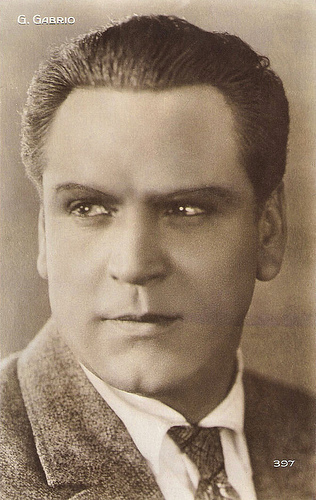
French postcard by Cinemagazine-Edition, Paris, no. 397.
Catapulted to Stardom
Dark-haired, blue-eyed Gabriel Gabrio was born Édouard Gabriel Lelièvre in Reims, France, in 1887. He was the youngest of sixteen children. Gabrio's father worked for the Pommeray Champagne cellars.
At the age of seven he developed a keen interest in puppet theatre. As a teen, Gabrio grew to an impressive height of 1 m 83 and after a stint as an apprentice glass window painter, set his sights on a career as a stage actor. He made his first appearance at the Casino of his home town. He also played for five years at the Kursaal.
At the outbreak of World War I, Gabrio enlisted in the French Army and served four years during the hostilities. After being demobilized, Gabrio relocated to Paris where he performed in such theatres as the Gaîté Rochechouart, the Théâtre des Ambassadeurs, the Comédie Montaigne and the Odéon in roles by George Bernard Shaw and William Shakespeare, among others.
Gabrio made his film debut in La fête espagnole/Spanish Fiesta (Germaine Dulac, 1920). In 1924 he was cast by film director Henri Fescourt to appear as Jean Valjean, the literary protagonist in the film adaptation of the Victor Hugo novel Les Misérables whose twenty-year-long struggle with the law for stealing bread during a time of economic and social depression is chronicled.
Gabrio's appearance in the film catapulted him to stardom. In 1927, Gabrio began appearing in international films, such as the German film Der Faschingskönig/Thre King of Carnival (Georg Jacoby, 1927), and in his first and only English language talkie The Inseparables (Adelqui Migliar, John Stafford, 1929) with Elissa Landi . Gabrio attempted to launch a Hollywood career in 1929. Sound, however, made that proposition untenable and he returned to France.
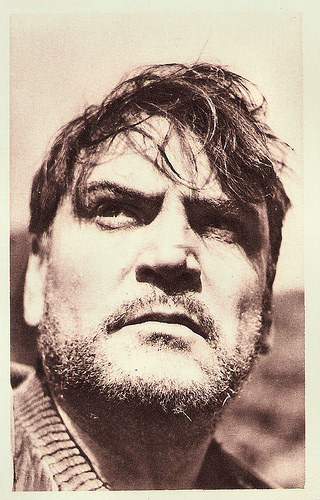
French postcard by Crépa, Editeur, Paris. Photo: Pierre Méré. Publicity still for Regain/Harvest (Marcel Pagnol, 1937) with Gabriel Gabrio as Panturle.
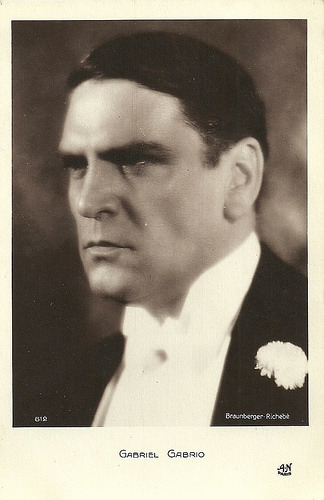
French postcard by A.N., Paris, no. 612. Photo: Braunberger - Richebé.
Unjustly forgotten
Gabriel Gabrio's career flourished in France into the 1930s. Memorable are the tough characters he embodied as the grumpy soldier Sulphart in Raymond Bernard's war drama Les Croix de Bois/The wooden crosses (1932). Gabrio then appeared opposite Edwige Feuillère in the historical biopic Lucrèce Borgia/Lucrezia Borgia (Abel Gance, 1935), a box-office hit.
He played Panturle in the drama Regain/Harvest (Marcel Pagnol, 1937) about a farming village where only three inhabitants remain. They are told that if only one of them, Panturle, manages to find a wife, the village will be able to prosper again.
Gabrio is possibly best recalled for his role as Carlos, the gangster cohort of Jean Gabin 's character Pépé le Moko in the 1937 film directed by Julien Duvivier. The film would become an international success and was remade in Hollywood as Algiers (1938), starring Charles Boyer , and as a musical, Casbah (1948), starring Tony Martin.
As the 1940s began and Europe was thrust into the World War II, Gabriel Gabrio's film career remained intact in war-torn France. In 1942 he appeared as the executioner, opposite Arletty and Marie Déa in Les Visiteurs du Soir/The Devil's Envoys (Marcel Carné, 1942), penned by Jacques Prévert and Pierre Laroche. The film premiered at Paris’s Madeleine Cinema on 4 December 1942 and was one of the biggest film events during the war. Les Visiteurs du Soir is an allegory of the eternal struggle between good and evil as fourteenth-century lovers defy the Devil. Many people saw the character of the Devil as representing Hitler and the continued beating hearts of the lovers as representing France living under German rule, but not giving up hope. Director Marcel Carné maintained until his death that the film was not an intentional allegory for the war and that any relationship was purely unconscious.
In 1943 Gabriel Gabrio's health declined and he retired into the village of Berchères-sur-Vesgre in the West of France. He died there in 1946 at age 59. The village has since named a street after him in his honour. Guy Bellinger at IMDb : “Gabriel Gabrio is unjustly forgotten and his 'hefty' contribution to the French cinema should be re-appraised.” Maybe the reappraisal start tonight in Pordenone.
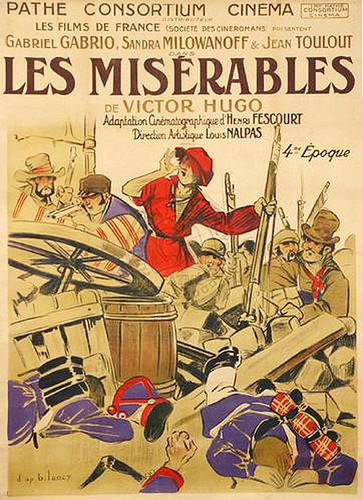
Affiche for Les Misérables (1924). Source: Philippe Freyhof@Flickr.
Sources: (IMDb), Hans J. Wollstein (AllMovie), Wikipedia and .

French postcard by Cinemagazine-Edition, Paris, no. 397.
Catapulted to Stardom
Dark-haired, blue-eyed Gabriel Gabrio was born Édouard Gabriel Lelièvre in Reims, France, in 1887. He was the youngest of sixteen children. Gabrio's father worked for the Pommeray Champagne cellars.
At the age of seven he developed a keen interest in puppet theatre. As a teen, Gabrio grew to an impressive height of 1 m 83 and after a stint as an apprentice glass window painter, set his sights on a career as a stage actor. He made his first appearance at the Casino of his home town. He also played for five years at the Kursaal.
At the outbreak of World War I, Gabrio enlisted in the French Army and served four years during the hostilities. After being demobilized, Gabrio relocated to Paris where he performed in such theatres as the Gaîté Rochechouart, the Théâtre des Ambassadeurs, the Comédie Montaigne and the Odéon in roles by George Bernard Shaw and William Shakespeare, among others.
Gabrio made his film debut in La fête espagnole/Spanish Fiesta (Germaine Dulac, 1920). In 1924 he was cast by film director Henri Fescourt to appear as Jean Valjean, the literary protagonist in the film adaptation of the Victor Hugo novel Les Misérables whose twenty-year-long struggle with the law for stealing bread during a time of economic and social depression is chronicled.
Gabrio's appearance in the film catapulted him to stardom. In 1927, Gabrio began appearing in international films, such as the German film Der Faschingskönig/Thre King of Carnival (Georg Jacoby, 1927), and in his first and only English language talkie The Inseparables (Adelqui Migliar, John Stafford, 1929) with Elissa Landi . Gabrio attempted to launch a Hollywood career in 1929. Sound, however, made that proposition untenable and he returned to France.

French postcard by Crépa, Editeur, Paris. Photo: Pierre Méré. Publicity still for Regain/Harvest (Marcel Pagnol, 1937) with Gabriel Gabrio as Panturle.

French postcard by A.N., Paris, no. 612. Photo: Braunberger - Richebé.
Unjustly forgotten
Gabriel Gabrio's career flourished in France into the 1930s. Memorable are the tough characters he embodied as the grumpy soldier Sulphart in Raymond Bernard's war drama Les Croix de Bois/The wooden crosses (1932). Gabrio then appeared opposite Edwige Feuillère in the historical biopic Lucrèce Borgia/Lucrezia Borgia (Abel Gance, 1935), a box-office hit.
He played Panturle in the drama Regain/Harvest (Marcel Pagnol, 1937) about a farming village where only three inhabitants remain. They are told that if only one of them, Panturle, manages to find a wife, the village will be able to prosper again.
Gabrio is possibly best recalled for his role as Carlos, the gangster cohort of Jean Gabin 's character Pépé le Moko in the 1937 film directed by Julien Duvivier. The film would become an international success and was remade in Hollywood as Algiers (1938), starring Charles Boyer , and as a musical, Casbah (1948), starring Tony Martin.
As the 1940s began and Europe was thrust into the World War II, Gabriel Gabrio's film career remained intact in war-torn France. In 1942 he appeared as the executioner, opposite Arletty and Marie Déa in Les Visiteurs du Soir/The Devil's Envoys (Marcel Carné, 1942), penned by Jacques Prévert and Pierre Laroche. The film premiered at Paris’s Madeleine Cinema on 4 December 1942 and was one of the biggest film events during the war. Les Visiteurs du Soir is an allegory of the eternal struggle between good and evil as fourteenth-century lovers defy the Devil. Many people saw the character of the Devil as representing Hitler and the continued beating hearts of the lovers as representing France living under German rule, but not giving up hope. Director Marcel Carné maintained until his death that the film was not an intentional allegory for the war and that any relationship was purely unconscious.
In 1943 Gabriel Gabrio's health declined and he retired into the village of Berchères-sur-Vesgre in the West of France. He died there in 1946 at age 59. The village has since named a street after him in his honour. Guy Bellinger at IMDb : “Gabriel Gabrio is unjustly forgotten and his 'hefty' contribution to the French cinema should be re-appraised.” Maybe the reappraisal start tonight in Pordenone.

Affiche for Les Misérables (1924). Source: Philippe Freyhof@Flickr.
Sources: (IMDb), Hans J. Wollstein (AllMovie), Wikipedia and .
Published on October 06, 2015 22:00
Paul van Yperen's Blog
- Paul van Yperen's profile
- 13 followers
Paul van Yperen isn't a Goodreads Author
(yet),
but they
do have a blog,
so here are some recent posts imported from
their feed.



